Jerome
Hill
Artist
Fellows
2019–21
Learn more about the program, or see Fellows in the 2025–2028, 2023–2025, or 2021–2023 cohorts.


Marjani Forté-Saunders (she/her) is a mother, choreographer, performer, a collaborative artist, community organizer and a three-time Bessie award winning choreographer and performer for her latest work, Memoirs of a... Unicorn. Marjani is an inaugural recipient of the UBW Choreographic Center Fellowship and a two-time Princess Grace Foundation awardee. Her work has been incubated in residencies at the Maggie Allesee National Choreographic Center (MANCC), Lower Manhattan Cultural Council Extended Life Residency, Brooklyn Arts Exchange, CUNY Dance Initiative, 651 Arts and Movement Research. Marjani has produced seven award-winning works in steady collaboration with her partner and composer Everett Asis Saunders (New Music USA Awardee) over the last ten years. Humbly, she defines her work by its lineage stemming from culturally rich, vibrant, historic, loving and irreverent conjurers!
Fellowship Statement
My storytelling is intended to thicken the common narratives of people of the African Diaspora, and stir up visions for human liberation. What might freedom, a reality that elevates culture, look like? I commit to the work of shifting and visioning through art. I dance to tap my heart and my prolific imagination, to ignite vision or desire for ontological integrity and ascension in my audiences. In dance, I can imagine my own liberation and engage a fantasy of free-being as a plausible reality. With Memoirs of a.. Unicorn, developed in collaboration with composer Everett Saunders, I've centered on thoughtfully sharing the work such that it reflects our core values:
- To echo and affirm the work of local community organizers
- To be malleable in design for unconventional spaces and limited resources
- And to explore and affirm the complexity of blackness as a unifying, expansive, cross-cultural concept and network.
Photo by Ian Douglas.
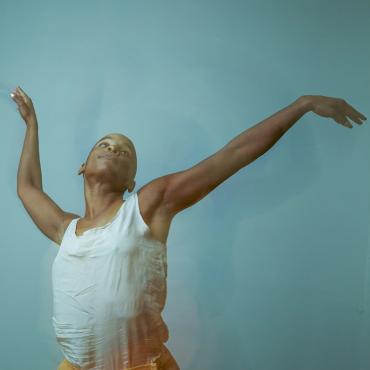

Jasmine Hearn (she/they) is a performer, director, choreographer, organizer, and teaching artist. A native Houstonian, she graduated magna cum laude from Point Park University with her BA in Dance. She currently collaborates with filmmaker and visual artist, Alisha B. Wormsley. Jasmine has worked and performed with David Dorfman Dance, Alesandra Seutin (UK), Solange Knowles, Kate Watson-Wallace, STAYCEE PEARL dance project, Marjani Forté-Saunders, Jenn Meridian, Helen Simoneau Danse, Lovie Olivia, Bill T. Jones/Arnie Zane Company and Nick Mauss (as part of the performance cast of TRANSMISSIONS—an exhibition at the Whitney Museum of American Art).
Jasmine is a 2018/2019 Movement Research artist-in-residence, was a 2018 Dancing While Black fellow, and was awarded a 2017 Bessie Award for Outstanding Performance as a part of Skeleton Architecture. They also received artist residencies at the Bronx Museum of the Arts, Jerome@Camargo Residency in Cassis, France, and Dance Source Houston. Jasmine is a vessel and storyteller using dance and sound as materials to make, teach, and perform around the world.
Fellowship Statement
The body of my work is rooted in the belief, born of language from my work with Marjani Forté-Saunders, Tara Aisha Willis, and Staycee Pearl, that I am a vessel for ancestry and spirt to speak through. I offer work that remembers and honors past, speaks of present, and prepares community for future. As a choreographer, dancer, sound-maker, and performer, I am investigating how the body is able to use memory, sensation, and imagination as ways to enter embodied practices to articulate story, ancestry, and personal truth. I use dance and sound as materials to conjure an environment to be experienced. I ask, “How can the body and voice act as bridges that connect communities with their individual truths and how these truths live together. Working as a freelance artist, I have had many opportunities to engage with community—teaching dance and movement classes, facilitating spaces for movement/sound exploration, performing in multidisciplinary projects, and creating intimate, immersive performance experiences. I am committed to the facilitating environments that gives space for folks to connect with their fantasies and feelings.
Photo courtesy of Whitney Browne Photography.


Choreographer/Director Raja Feather Kelly (he/him) is the artistic director of New Brooklyn Theatre. In 2009 he founded the dance-theatre-media company the feath3r theory. The two companies merged in 2018. Raja has been awarded a Breakout Award from the Stage Directors and Choreographers Foundation (2018), Dance Magazine's inaugural Harkness Promise Award (2018), the Solange MacArthur Award for New Choreography (2016), and, twice, the Princess Grace Award (2017, 2018). He was born in Fort Hood, Texas and holds a BA in Dance and English from Connecticut College. Raja has been awarded a New York Dance Performance Bessie Award, a Bessie Schonberg Fellowship at The Yard, a DanceWEB Scholarship, a New York Foundation for the Arts Choreography Fellowship, a HERE Arts Fellowship, a 2018 Creator-in-Residence at Kickstarter and a Choreography Fellowship at the Center for Ballet and the Arts at New York University.
Fellowship Statement
I am obsessed with the development of popular culture over the last thirty years. My work unabashedly appropriates the structures, themes, and aesthetics found in reality television, celebrity culture, and social media (YouTube, Instagram, Facebook), then deconstructs it into new works which combine dance, theatre, and visual media. My aim is to challenge audiences to recognize their own implication in popular media: how media has trained and molded their desires, relationships, and identities. My movement-based performances combine fashion shows, gallery exhibitions, drag, stand-up comedy, minstrel shows, and stage-plays into a single, overwhelming, over-saturated Gesamtkunstwerk in which artists and audiences experience their shared humanity. I rehumanize our over-mediated experience of reality.
Photo by Thomas Dunn.
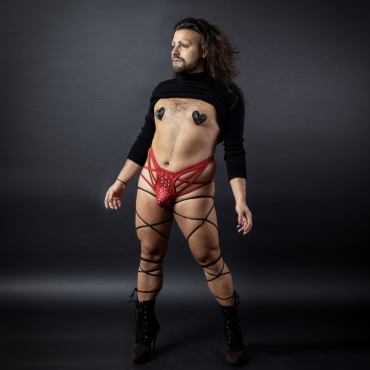

Pedra Pepa (they/them) is a Venezuelan, queer Latinx performance artist, as well as a teaching artist with Pillsbury House Theatre and Upstream Arts. They have performed and produced over ten Drag Story Hours at multiple Twin Cities locations, supported by a Minnesota Center for Humanities grant. Doña Pepa, Pedra’s drag/burlesque persona and choreographic lens, has graced stages locally (First Avenue Mainroom, Minneapolis Burlesque Festival, Lush, Gay 90’s, University of Minnesota) and in Puerto Rico. Noche Bomba, which incorporates Doña Pepa, was presented by 20% Theatre’s Q-STAGE and will tour to Winona State University in April 2019. Solo-versions were performed at Walker Art Center’s Choreographers’ Evening and at Galería Oro in Vieques, Puerto Rico. Pedra’s newest work, Holy Doña, will premiere at Red Eye Theatre’s 2019 New Works 4 Weeks Festival. Initial research for this project has been shared at 1er Coloquio sobre Hombres+ y Masculinidades in San Juan, Puerto Rico.
Fellowship Statement
I am Pedra Pepa. I am a queer, gender-fuck, Venezuelan immigrant, Latinx, brown performance maker in Minneapolis.
My choreographic work is deeply personal, it is about my everyday experience, the coexistence of my oppressions and my identities. I create work that denounces current injustices. The work begins within me, then I transfer it to and cultivate it with other performers. I play with movement expression, singing, sound-making, draglesque, and visual media to create specific imagery, supported by costumes and props. I am interested in facilitating emotional journeys for audiences to ride with me and the performers.
“Draglesque” is my current solo research, a larger-than-life expression/explosion of gender, where my body transcends all social parameters. A space of radical freedom and self-love. This process is how I finesse and craft my skills as I mold my character(s). It is both a celebration and a transgression
Photo by Nic LaFrance.
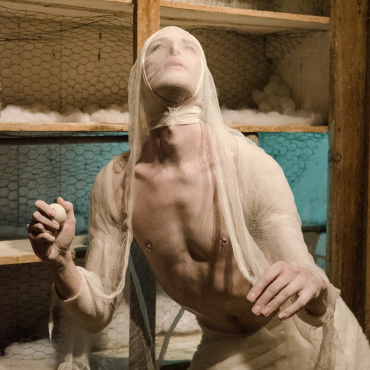

Dustin Maxwell (he/him) is a dancer, choreographer and visual artist originally from Albuquerque, New Mexico, now based in Brooklyn, New York. In New Mexico he trained in Graham and Limon with his dance “mother,” Joanne Emmons. He has a BA in Dance from the University of Minnesota and extensive training in Yoga and Butoh. As a freelance dancer he has worked with Aniccha Arts, Chris Schlichting, Morgan Thorson, and many others. His choreography and performance installations have been shown in galleries, theaters, basements and alleyways in Minnesota, New York and Germany. He was a nominee for the 11th Annual Sage Awards, Outstanding Performer.
Fellowship Statement
I work primarily within the modalities of somatic improvisation and butoh. Being born queer into a Mormon family of eight has shaped my perspective in many ways. Sexuality, spirituality and the experience of otherness are major themes in my work. My choreography is highly visual and minimal in movement relying on the innate history, ancestry, cultural identity and politics inherent in the body. My body is a field for knowing that which is seen and unseen; that which lies beyond the boundaries of the mundane. My artistic endeavors use performance as a method for connecting with others at this essential level and perhaps provoking “awakeness.” I believe this expands the limits of consciousness which is a radical and subversive action.
Photo by Justin Hickman.
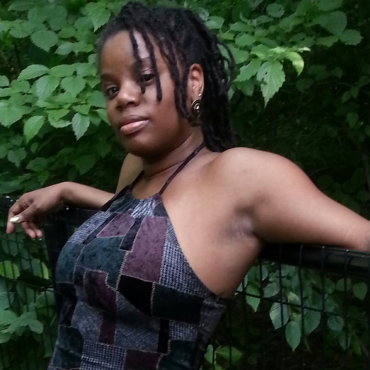

Leslie Parker is a dance artist, performer, director, maker, improviser and educator holding a BFA from Temple University in Choreography and Modern dance technique and a MFA from Hollins University in partnership with the Künstlerhaus Mousonturm, The Frankfurt University of Music and Performing Arts and The Dresden Frankfurt Dance Company in Frankfurt, Germany. Leslie is a 2017 Bessie award winner and a Jerome Hill Foundation Artist Fellow 2019 -2021. She has a rigorous research and practice in dance forms derived of the African Diaspora. She designed “Moving Dialogue for Non-Violence” using dance art as a platform for Broadway Women’s House Shelter in Brooklyn, New York and at The Family Place in Saint Paul, MN. She is currently a member of the collective, Skeleton Architecture based in New York. Her director credits include co-director and choreographer for IHOTB MayDay Tree of Life Ceremony; choreographer for Jimmy & Lorraine: A Musing by Talvin Wilks; and Ping Chong and Talvin Wilks for Collidescope 4.0.
Additional credits include, crystal, smoke n’spirit(s) presented by Momentum: New Dance Works at Frey Theater St. Catherine’s University; Crossroads/Gateways pt 2. at the Walker Art Center’s Choreographer’s evening; Bone Womyn Traces in Black at Hollins University (Roanoke, VA) and at Southern Theatre; Ripen: Forbidden Truth In da Flesh Pt.2 at Pillsbury House Theatre “Mama Laurie’s Late Nite Series”; Center for Performance Research's Fall Movement Series (NY, NY); and New York Live Arts. Parker choreographed an original work, In Search of Colors, as faculty for University Dance Theater (UDT) at U of MN Theatre and Dance dept. Currently, Leslie Parker Dance Project, is in residence for Spring 2021 at Pillsbury House Theater and Pangea World Theater.
Fellowship Statement
I am a dance artist, performer, dance maker, educator and improviser, trained in and experimenting with an aesthetic rooted in the Black experience. I make dances that explore spirituality, identity and social justice to spark questions and conversations with and between people. As an improviser, I invite observers to a real-time exchange through movement, sound, space and the body. Described by choreographer Bill T. Jones as “haunting,” former Director of Quixote Foundation, June Wilson describes the experience of “watching Parker’s work is like being a voyeur; the intimacy and emotional energy of her movement makes you want to look away and yet it’s impossible to stop watching.”
Photo courtesy of Leslie Parker.
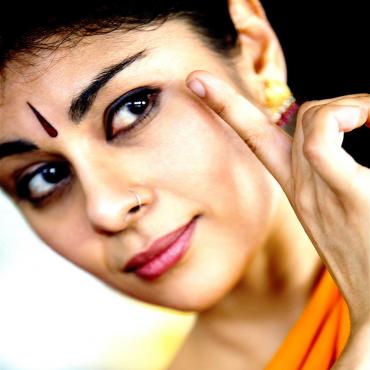

As an independent choreographer and Choreographic Associate with Ragamala Dance Company, Ashwini Ramaswamy’s (she/her) work references ancient myths and ritualistic practices, global literature and poetry, and the mixed media contemporary culture she has absorbed for over 30 years. Her work draws from myriad influences to express a personal identity with universal resonance. Celebrated for her ability to “[weave] together, both fearfully and joyfully, the human and the divine” (New York Times), Ashwini has studied Bharatanatyam since the age of five. She has toured extensively with Ragamala, performing throughout the U.S. and in Russia, Taiwan, Indonesia, Japan, the U.K, and India. Ashwini's choreographic work has been presented by the Cowles Center, the Yard, and the Joyce Theater, among others. Her work is supported by the National Endowment for the Arts, the Jerome Foundation, the Mid Atlantic Arts Foundation’s US Artist International, and the New England Foundation for the Arts’ National Dance Project, among others.
Fellowship Statement
I have spent decades steeped in the south Indian classical dance form of Bharatanatyam. I am committed to maintaining the beauty, technique, rigor, and values embedded in the form as it has been taught to me, while creating my own personal vision of women’s representation in performance. Like a phantom limb, my Indian ancestry lingers within me, informing my artistic work and daily interactions; my upbringing in both India and the U.S. has encouraged an aesthetic perspective with a hybrid internal compass. As an artist of diaspora, I am a cultural carrier with an instinct to move within ancestral patterns. There is a continuum between what we perceive as real/tangible and what we accept as unknown/unknowable; this gravitation between the human, the natural, and the metaphysical—which are forever engaged in sacred movement—is a focal point in my work.
Photo by Ed Bock.


Deneane Richburg (she/her) grew up a competitive figure skater, spending time in spaces where she felt she had to check her racial/cultural identity at the door, as the predominantly white skating world excluded her ancestry’s truths. To quote Zora Neale Hurston, Deneane always felt “most colored when [she was] thrown against a sharp white background.” As an adult, she realized the need to carve out a space for her ancestral history, so she established Brownbody, a creative home for her artistic work that fuses theater, dance, social justice practice, and skating. Through Brownbody, she honors the complex narratives of Black diasporic communities. As a modern dance choreographer and skater, Deneane is interested in expanding creative expression on the ice by engaging ancestral narratives as a framework for movement exploration. Deneane is a grateful recipient of a 2017 McKnight Choreography Fellowship administered by the Cowles Center and funded by The McKnight Foundation.
Fellowship Statement
I fuse different movement worlds; a modern dance choreographer that presents works on and off of the ice. The themes of my work range from visual objectification through the story of Saartjie Baartman to issues of re-memory through a piece based on Toni Morrison’s Beloved. My latest on ice evening length work is Quiet As It’s Kept, which focuses on the Reconstruction era and rise of Jim Crow laws. I’m interested in ensemble work on the ice. As a dancer I’ve performed with companies in ensemble pieces and have learned to appreciate the intricacies and manipulation of group nuances—engaging many bodies to create a fully realized and unified statement. I am interested in exploring the power of these elements on the ice in telling stories relevant to my ancestral history. Currently I am working on an ice ensemble piece that explores American Black social dances of the 17th through 19th centuries.
Photo by Alice Gebura.
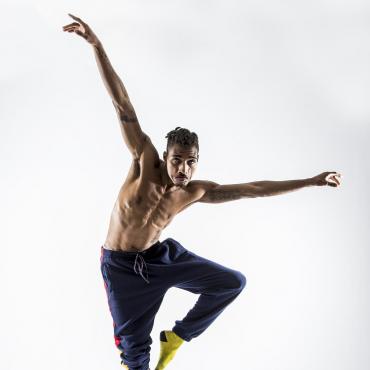

Darrius Strong (he/him) is a Twin Cities based choreographer, dancer, and educator whose creative work has been performed in Walker Art Center’s Choreographers Evening and Rhythmically Speaking. He was featured in the 2015 New Griots Festival as well as an American Standard Billboard advertisement in New York City Time Square in 2016. He was a 2017 Momentum New Works recipient. Strong has created works for Threads Dance Project, Flying Foot Forum, Alternative Motion Projects, and most recently was commissioned to create a new work for James Sewell Ballet. Strong developed his own dance company STRONGmovement in 2015. He is a faculty member at Saint Paul Conservatory Performing Arts High School, TU Dance Center. At Eleve Performing Arts Center, he teaches young dancers how to connect their identity to movement. Strong is also a company member of Stuart Pimsler Dance & Theater.
Fellowship Statement
I tell stories through movement. I feel that our bodies tell stories and it’s up to us as individuals to define those stories. As a child it was hard for me to communicate my feelings through words, so I began to rely on movement as an outlet in times of sadness, frustration, anger, and other emotions.
I created my own dance company, STRONGmovement, because I truly believe that movement empowers conversation between dancers and audiences. Conversation invokes community building, an aspect of my background in hip hop I center in my work. Through the movement I create, I desire to empower others, create communities, inspire people to invest in themselves and their stories.
Photo by Bill Cameron.
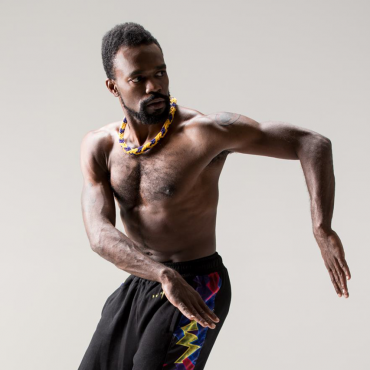

André M. Zachery (he/him) is an interdisciplinary artist and founding artistic director of Brooklyn-based Renegade Performance Group (RPG). Zachery’s practice, research and community engagement artistically focuses on Black/African Diaspora cultural practices through the mediums of choreography, site-specific projects, film, digital projection, audio installations and responsive technology. He is a former Jerome Foundation supported Movement Research artist-in-residence and a 2016 New York Foundation for the Arts Fellowship/Gregory Millard Fellow in Choreography. He has served as a guest faculty artist in dance departments at Florida State University, Virginia Commonwealth University and Ohio State University. His works have received acclaimed reviews from the New York Times, Culturebot and other notable publications. RPG has presented work at Danspace Project, The Kennedy Center, Wexner Center for the Arts, Harlem Stage and the Brooklyn Museum. Zachery extensively collaborates with artists of various genres and mediums to create innovative projects that expand notions of performance and space.
Fellowship Statement
I am interested in dimensionality as a means to disrupt and dismantle hierarchy. Currently, my work and research in Afrofuturism reconsiders the relationship of the Black body in digital landscapes to recoding (virtual) reality. The presence, experiences and narratives of the African Diaspora are severely lacking in the field of performance and technology. For me dimensionality offers the ability to shape and form our stories, legacies, myths and sense of place with complexity and nuance in consideration to time. Moving forward, I want to find ways to actualize the conversation and theory of Black futurity into physical and material spaces. I want people to input their information into a constructed environment where the material and physical architectures interact cohesively with supporting sonic and visual elements, exploring how Afrofuturism can be a generative mechanism to address societal issues with parity, equity and resourcefulness
Photo by Rachel Neville.
Finalists in dance who agreed to be publicly acknowledged include: Hadar Ahuvia, Ephrat Asherie, Fana Fraser, Catherine Galasso, Abigail Levine, Same As Sister/Briana Brown-Tipley + Hilary Brown
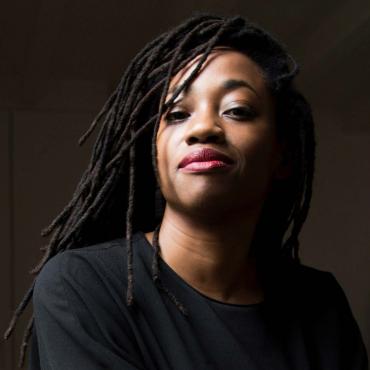

Shirley Bruno (she/her) holds Masters from London Film School and Le Fresnoy - Studio National des Arts Contemporains where she was an artist fellow. Shirley's shorts have received awards at major festivals including the Off-Limits Prize in Competition for her experimental short AN EXCAVATION OF US at Annecy International Animated Film Festival (2018) and the Prix Ars Electronica Honorary Mention (2018). Her docufiction TEZEN was awarded prizes from the National Greek Film Centre (2017) and the StudioPrix Collector (2016) initiated by art collectors Isabelle and John-Conrad Lemaître. She has received funding and support for her work from New York State Council on the Arts, New York Foundation for the Arts, Jerome Foundation, La Cité International, and LIM—Less is More part of Le Groupe Ouest.
Fellowship Statement
Shirley’s films draw from her heritage preserving and radicalizing her ancestral traditions and mythology. She creates modern myths that expose the slippery spaces between the material and metaphysical world, documentary and fiction, between collective memory and history. She explores the everyday, the Sacred, and the intimate violence in the things left unsaid that mark us generation after generation. Her work often takes its point of departure from neglected histories as well as from rumors, dreams, superstitious beliefs, and memories both real and imagined. Currently, Shirley is developing her first feature film, an intimate meditation on women, land, and family legacy.
Photo by Léa Girardin.


Jason Coyle (he/him) and Laska Jimsen (she/her) work across nonfiction forms from video documentary to 16mm filmmaking. Their individual and collaborative work has screened at festivals and venues including Ann Arbor, Athens, Big Muddy, IC Docs, Los Angeles Filmforum, Cellular Cinema, and Walker Art Center. Laska and Jason are individual recipients of Minnesota State Arts Board Artist Initiative Grants and a Jerome Foundation Minnesota Film & Video Grant. Laska is Associate Professor of Cinema & Media Studies at Carleton College; Jason is Associate Professor of Media Arts at the Minneapolis College of Art & Design.
Fellowship Statement
Our experimental nonfiction film and video work foregrounds acts of observation in sustained investigations of human-animal relationships, systems of management and classification, and representations of the everyday. Our ongoing series Almanac is a collection of formal studies of light, motion, and time, exploring sensory dimensions of seasonal states through singular moments in afternoons across the year. Research is integral to how we conceive of and create longer-form documentaries. We are currently developing new projects that draw on the history of automation and pose questions about contemporary labor and workplace transformations.
Photo (Jason Coyle and Laska Jimsen’s Deer of North America 2017) courtesy the artists.
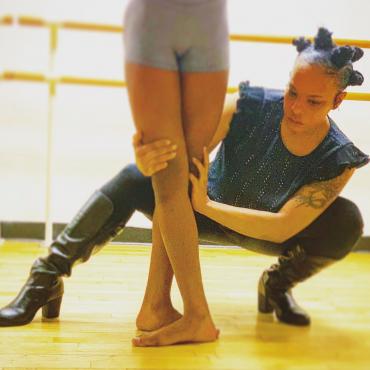

Kerri Edge (she/her) is an artivist who uses dance and film as vehicles to shed light on issues of social injustice and commemorate the achievements of African American people. She is Artistic Director of the Edge School of the Arts (ESOTA), which was founded in the image of the Bernice Johnson Cultural Arts Center (BJCAC). ESOTA is dedicated to bringing the art and discipline of African American dance to young aspiring artists and audiences, from local to international. Kerri began her dance training at the age of three at BJCAC in Jamaica, Queens where she met her mentor Michael Peters, who sparked her interest in dance for film. She continued her studies at The Eglevsky Ballet School, LaGuardia High School, Alvin Ailey American Dance Theater, The Martha Graham School, and SUNY Purchase. She earned her Masters in Arts Administration from New York University and is currently a Professor of Dance at Medgar Evers College. Her commitment to the Jamaica arts community is evidenced by her volunteer work with the Jamaica Is . . . Arts Alliance, the Afrikan Poetry Theatre, the Greater Jamaica Development Corporation and the Queens Sickle Cell Advocacy Network.
Fellowship Statement
I am an artist making sense of the world that I am a part of; I would like to leave a trace in forms that are felt and experienced for all people, now and for future generations. I am an artivist grappling with notions of memory and time, along with the role of African American-based dance rituals and body memory, through all of the senses, finding locations for where they intersect and create sensations of depth and wonder.
My 4 Little Girls film uses the universal languages of photography, song and dance to depict stories from the American Civil Rights Movement. An extensive education component helps children and adults explore history together through the use of objects from a vast collection of expressive poster samples from the Civil Rights Movement, lessons on two important social issues, and engaging hands-on activities. REFORM: Racial Disparities in the American Justice uses tap dance as a vehicle to shed light on the racial disparities in the American criminal justice system encouraging others to advocate for legislation. The collection of tap dance monologues set to music, poetry and film tell stories that highlight the African American male experience with the criminal justice system and the lasting effects on both the African American family and the community at large. The short stories are compiled into a unified work that stands with victims threatened by the increased discrimination and encourages audience members to realize the promise of equality America makes to us all.
Photo by Saiku Branch.
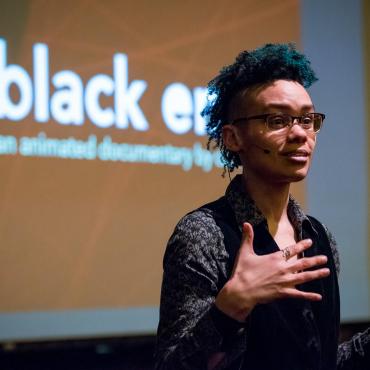

Carrie Hawks (they/them) makes art to investigate gender, sexuality, and race and promote healing. Their works have been exhibited at the Ann Arbor Film Festival, the Brooklyn Museum, CinemAfrica (Stockholm), Cape Town, and Tokyo. Animation, drawing, collage, sculpture, doll-making and performance are all vital parts of their art practice. They harness the magic of animation to tell stories. Their film black enuf*, partly funded by Jerome Foundation, was nominated for a New York Emmy, won numerous festival awards and had its broadcast debut on American Public Television’s World Channel in 2019. They have performed with Black Women Artists for Black Lives Matter, and participated in the Set on Freedom Artist Residency at the Queens Museum. They hold a BA in Art History & Visual Arts from Barnard College and a BFA in Graphic Design from Georgia State University.
Fellowship Statement
My art confronts self-imposed and external assumptions about identity in order to promote healing, particularly in relation to race, gender, and sexuality. My work highlights stories that are not being represented enough. My practice presents alternate ways of connecting through a variety of media including animation, drawing, collage, sculpture, and performance. I also incorporate humor. In performance, I have asked participants to tell me about their nemeses so that we could destroy them on paper. In film, I’ve asked “if I am Black enough” for my peers and myself, and what Blackness is. I search for strategies to address being an outsider and holding self-love. My art exudes strength in its honesty, craft, and visual metaphors. I draw upon my insecurities, confusion, and fear and invite the audience to reflect on theirs. My current project, Inner Wound Real, focuses on people of color and their experiences with self-injury.
Photo courtesy of Nelson-Atkins Museum.
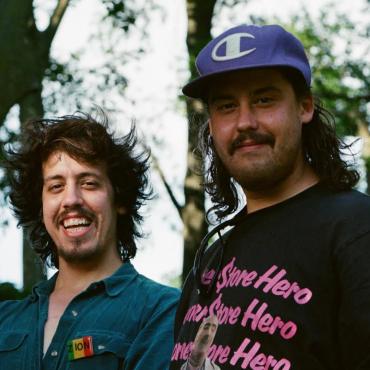

Adam Khalil (he/him) and Zack Khalil (he/him) (Ojibway) are filmmakers and artists from Sault Ste. Marie, Michigan and are currently based in Brooklyn, New York. Their work subverts traditional forms of ethnography through humor, transgression, and innovative documentary practice. Their films and installations have been exhibited at the Museum of Modern Art, Sundance Film Festival, Walker Art Center, Lincoln Center, Tate Modern, the Whitney Museum of American Art, UnionDocs, e-flux, Maysles Cinema, Microscope Gallery (New York), Spektrum (Berlin), Trailer Gallery (Sweden), and Carnival of eCreativity (Bombay). They both graduated from the Film and Electronic Arts program at Bard College and are UnionDocs Collaborative Fellows and Gates Millennium Scholars.
Fellowship Statement
Our work centers indigenous narratives in the present—and looks towards the future—while subverting traditional forms of ethnography through humor, transgression, and innovative nonfiction practice. With a practice that includes experimental filmmaking, documentary, performance & curation, we are charting out a critical & unconventional space for situating & interrogating ideas of indigeneity today.
Photo by Bayley Sweitzer and Sam Richardson.
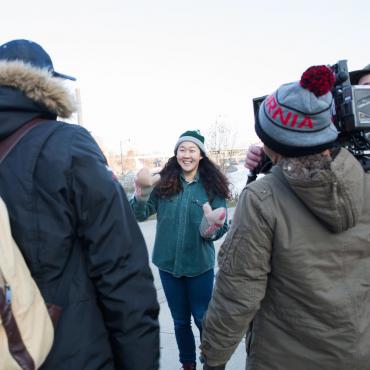

Naomi Ko (she/her) is a writer, actor, filmmaker, and cultural producer. Her TV pilot, NICE, was an official selection at the 2018 Tribeca Film Festival. Naomi created, wrote, and starred in the half-hour pilot. Naomi also played Sungmi in the 2014 Sundance award-winning feature film Dear White People, is a Moth StorySlam winner, and a featured performer for Mortified. Naomi performs with Funny Asian Women Kollective (FAWK) around the country and her comedic writing and performance can be seen in Episode 5 of The Mortified Guide, now available on Netflix. Naomi is the co-founder of the APIA MN Film Collective and has won multiple grants, awards, and fellowships for her work. Naomi is currently in pre-production for an upcoming short film she is directing and she is developing her feature film Good Genes.
Fellowship Statement
My work primarily focuses on creating unapologetic and raw film and TV narratives that feature fearless Asian American women. Even though the genres I play with can span from a raunchy sports comedy to a historical drama, at its core, each story explores the diversity of spirit, personality, and interests of Asian Americans in a grounded and humanistic lens. Currently I am exploring the ways in which Asian American women exercise their agency through my next feature film, Good Genes. It is a black comedy about a group of scientists of color who create their own personal genetics ancestry company to alter the genetic ancestry of known racists and white supremacists.
Photo by Katherina Vang.
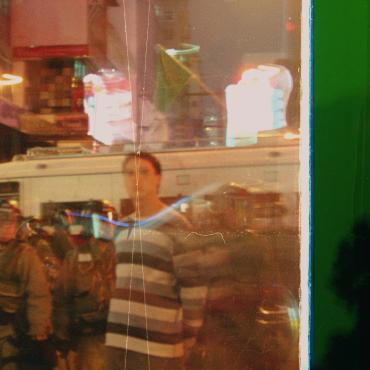

Simon Liu (he/him) was raised between Hong Kong and Stoke-On-Trent, UK and lives in Brooklyn. His films and 16mm multiple projections have been presented at film festivals globally including the Toronto, Rotterdam, BFI London, Edinburgh and Hong Kong International Film Festivals. He has performed at institutions such as the M+ Museum, Tai Kwun Contemporary, CROSSROADS at SFMoMA, Yale University and as part of Dreamlands: Expanded—an expanded cinema series presented by the Whitney Museum of American Art and Microscope Gallery. Liu is an adjunct faculty member at the Cooper Union School of Art and a member of Negativeland, an artist-run film lab in Brooklyn. He has received grants from the New York State Council on the Arts, Wave Farm and the Jerome Foundation. He is in post-production on his first feature, Staffordshire Hoard and is developing a film which imaginatively traces the passage of an ancestor who traveled from Guangzhou to Amsterdam by foot.
Fellowship Statement
In recent years my practice has centered around building a filmic catalogue from my places of origin through a body of work consisting of abstract diary films, alternative documentaries and 16mm projection performances. These works act as a storage mechanism that activate the potential for me to reconsider my formative experiences and how they relate to my position as a half Chinese, half English person who was born and raised in the former British colony of Hong Kong. I’m driven by a desire to compress fleeting exchanges into a single frame—by exploiting the material potential of “outdated” analogue formats—with the intent of relaying an exaggeratedly contemporary experience. Currently I’m working on a suite of 16mm films which call into question the ethics of image making and two feature documentaries that interrogate personal family mythologies in relation to centuries old histories of South China and the English Midlands.
Photo: Still from E-Ticket (2019) - Photo of the Artist at a WTO Protest in 2006.


Kate Marks’ (she/her) film PEARL WAS HERE has over 25 million views on YouTube. She is a 2016 HBO Access Directing Fellow as well as a 2013 Project Involve Fellow (Barbara Boyle Award winner). She directed the HBO Access pilot MANIC, which premiered in the 2017 Tribeca Film Festival and received Best Drama from the New York Television Festival and Best Actress in a Drama at Series Fest. Her award-winning shorts (PEARL WAS HERE, HOMEBODY, 7 DAY GIG, and MIRACLE MAKER) continue to screen all over the world, including Slamdance, Edinburgh International, Palm Springs ShortFest, New Orleans, Austin, Nashville, Atlanta, and Cleveland International Film Festival as well as broadcast on PBS.
Kate holds a BA from Brown and her MFA in film-directing from CalArts where she received the Beutner Award for Excellence in the Arts. Additionally, Kate is an organizer, a teacher, a stilt-walker, a bad trombonist, and a reckless dancer.
Fellowship Statement
I come from a long line of tricksters. My grandpa was famous for his epic pranks and my dad was a legendary wild man. Telling tall tales is in my blood and (like a good trick) my films use comedy, surprise, and spectacle to take you somewhere unexpected. My stories feature oddballs, misfits, and losers and I love experimenting with tone, mining humor out of dark situations. I am currently working on my first feature, THE COW OF QUEENS. In the final days of her father’s illness, Sonya and her dad, Del, go on one last adventure to usher an escaped slaughterhouse cow to freedom through the streets of New York. It’s an off-kilter love story about a dad, a daughter, a cow with a dream, and the good people of Queens.
Photo by Jamie Milner.
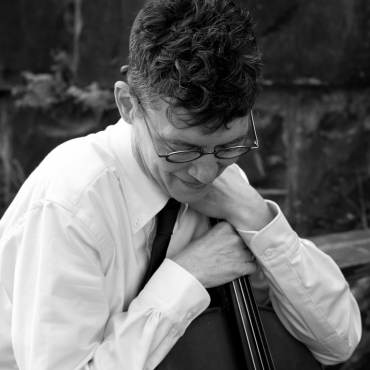

As a media composer and installation artist, Kathy McTavish (ze/hir) creates chance-infused, open systems. Ze uses generative methods to build networked, multichannel video and sound environments ::: cross-sensory, polyphonic landscapes which flow from the digital web (the cloud) into physical spaces.
Kathy has a background in cello performance, mathematics, ecology, music theory and code. The confluence of these disciplines informs hir work as a composer and multimedia artist. As both a musician and a mathematician, Kathy likes multi-threaded, dynamical systems and chance-infused, emergent patterns. As a queer artist, ze is interested in the ways we construct personal stories / myths and the infinite, bendable between.
Kathy’s current work explores the porous, intimate boundaries between humans and machines ::: the erotic dynamics of tapping glass ::: the carbon cycle ::: the cyborg body ::: the fragile electric body ::: the resistance cyborg ::: the networked, digital hive mind ::: the swarm.
Fellowship Statement
I like patterns but my work explores chance & improvisation. Mathematical models are a score. They are a blueprint to draw contours of change and movement ::: convergences, divergences, emergent patterns and cascading, system-level impacts.
Chance is a frayed thread, a stochastic cloud, a pointillist field, a complexity, an uncertainty, a ragged line. Chance is a prayer ::: a slim window of chance to survive this time of profound climatic change. Evolution requires fruitful deviation. A system's ability to adapt to change depends on its ability to mutate ::: on trial & error & improvisation.
I am interested in the poetics of code ::: the networked (i) ::: a deviant, queer learning machine ::: aerial artist ::: (m)bodied cloud ::: burlesque, cybernetic ze ::: beat poet of electricity ::: a honey ::: a lure ::: a torrent.
Photo by Magic Box Photography, Duluth, MN.


Richard Wiebe’s (he/him) award-winning work has screened widely at international film festivals including IFF Rotterdam, Media City, Cannes Cinéfondation, FIDMarseille, Festival du nouveau cinéma Montreal, UnionDocs Center for Documentary Art, Ann Arbor Film Festival, and several others. He is the recipient of grants from the Princess Grace Foundation and the Minnesota State Arts Board. Richard teaches courses in sound design, screenwriting, and the art of the short at Hamline University and FilmNorth. He is the Experimental Cinema programmer for the Minneapolis/Saint Paul International Film Festival (MSPIFF) and a member of the collective Cellular Cinema.
Fellowship Statement
My current project-in-progress is a feature-length experimental documentary focusing on World War I cameraman Leon Caverly, the first official war cinematographer of the United States military. Using Caverly’s pro-war cinematography found in the National Archives, I will fashion an anti-war film. Caverly shot the film 100 years ago, I will edit and do the sound design. This constraint-based collaboration with Caverly will also include materials from early American cinema, television, and other archival sources, alongside contemporary footage I have shot. Ultimately, this project will result in a de-stratified history of American militarism from the canons of the Confederacy at the Siege of Petersburg to depictions of unrest today. World War I propaganda, where cinematic propaganda first blossomed, is the center that holds it all together.
Finalists in film/media who agreed to be publicly acknowledged include: Ivan Cortazar, Lanre Olabisi, Alfonso Rodriguez, Maribeth Romslo, Anna Samo, Dan Schneidkraut, Lily Jue Sheng
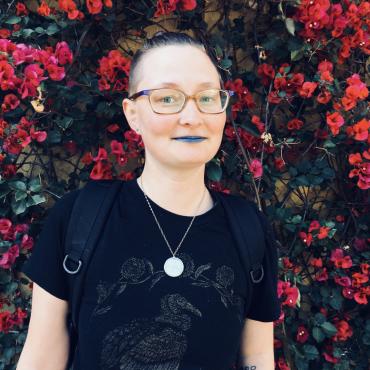

D. Allen (they/them) is a multidisciplinary poet and artist living in Minneapolis. Their first hybrid poetry collection, A Bony Framework for the Tangible Universe (The Operating System, 2019), weaves together poems, lyric essays, dictionary erasures, and images in response to the poet's diagnosis with a connective tissue disorder, asking: What holds us together when the body falls apart? D.’s writing has appeared in QDA: A Queer Disability Anthology, District Lit, Rogue Agent, Lockjaw Magazine, Black Warrior Review, and elsewhere. D. has recently received a Minnesota State Arts Board Artist Initiative Grant, an Emerging Artist Grant from VSA Minnesota, and a Minnesota Emerging Writers’ Grant from The Loft; they have been a resident at the Mallard Island Artist Residency, The Lighthouse Works, Write On Door County, the Andrews Forest, and the Atlantic Center for the Arts. D. earned an MFA in Creative Writing at the University of Minnesota in 2017.
Fellowship Statement
D.’s poetic practice is oriented around presence. Their work takes many forms: word architectures, light drawings, textured surfaces, slow dinners, layered sounds, sustained listening, temporary assemblages, quiet gardening, exploratory movements. Through their work across media and disciplines, D. navigates pain and illness, queer kinship, sex and intimacy, the natural world, and the realities of queer, genderqueer and disabled embodiment. Collaboration and relationship-building are vital to D.’s artistic life.
Currently, D. is developing their first full-length stage work using text, images, light, sound, movement, and large-scale handknit textiles with the support of a 2019 Q-Stage: New Works Fellowship from 20% Theatre Company. D. is also working on a collection of researched lyric essays, while pursuing new collaborations and smaller-scale experimental projects across disciplines.
Photo by poet Roy G. Guzmán.
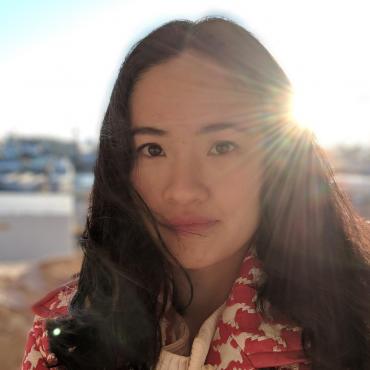

Chia-Lun Chang (she/her) was born and raised in New Taipei City, Taiwan. Her work appears in Literary Hub, PEN America, Hyperallergic, Bettering American Poetry Volume 2, Vinyl, Los Angeles Review of Books, Brooklyn Rail, and Bone Bouquet, among other publications. She’s the author of a chapbook, One Day We Become Whites (No, Dear/Small Anchor Press, 2016) and has been supported by fellowships from the Ministry of Education in Taiwan, the Brown-Tougaloo Partnership, Lower Manhattan Cultural Council, Tofte Lake Center, and Poets House.
Fellowship Statement
I came to the United States to continue my studies, earning a second bachelor’s degree in Fine Arts and a master’s degree in poetry. In these programs and through my work in the writing community, I have deepen my understanding of colonization, women’s rights, and patriotism. Even today, it is difficult to find authentic representations of Taiwan, written by ethnic minorities and native people. Seeking representation, I found two books which spoke to me—Notebook of a Return to the Native Land by Aimé Césaire and Dictée by Theresa Hak Kyung Cha. I admire Césaire for combining anger, violence, colors and temperatures. In Dictée, Cha uses the text as an extension of her body and demonstrates the possibility of developing one’s own multilingual, hybrid-genre voice. With Cha and Césaire as my guides, I have been working on a poetry memoir in which I grapple with the conflict and confusion of identity issues, the lost history of island residents, postwar survival, the causes of female oppression, and the act of speaking out. As a Jerome Hill Artist Fellow, I will expand my first chapbook, One Day We Become Whites, into a book-length project—a Taiwanese poetry memoir.
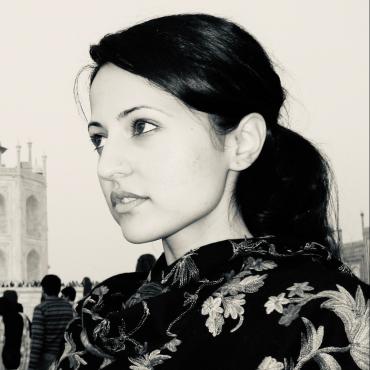

Pallavi Sharma Dixit (she/her) earned a Master of Fine Arts in creative writing from the University of Massachusetts Amherst. She is the recipient of a number of grants and fellowships and has taught creative writing at the Loft Literary Center. She lives in Minneapolis with her husband and two children and is at work on a novel.
Fellowship Statement
I was born in India and raised in Edison, New Jersey – a Little India in America – and this history informs all my writing.
When I earned degrees in history from the University of Pennsylvania I didn’t know how I would use them, but it turns out this is how: my fiction examines Indian immigration, Thomas Edison’s work ethic, anti-Indian racism, the evolution of Indian film, and the transformation of an American suburb into an ethnic enclave.
My novel-in-progress, Edison, deals also with romance, obsession, anxiety and the pressure of the American Dream. It is influenced both by the Bollywood movies and American sitcoms I grew up on. At every turn it bears the imprint of my life.
I try not to let my process be all agony; I find the humor and amuse myself. I like when movie stars unexpectedly enter my scenes. And I like em dashes so much.
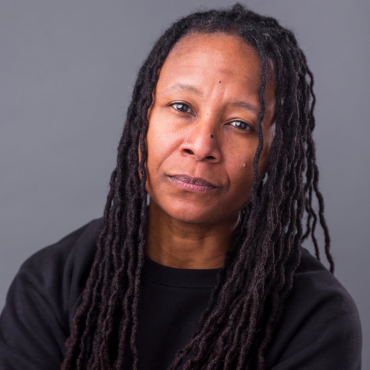

t’ai freedom ford (she/her) is a New York City high school English teacher and Cave Canem Fellow. Her poetry, fiction, and essays have appeared in The African American Review, Apogee, Bomb Magazine, Calyx, Drunken Boat, Electric Literature, Gulf Coast, Kweli, Tin House, Obsidian, Poetry and others. Her work has also been featured in several anthologies including The BreakBeat Poets: New American Poetry in the Age of Hip-Hop and Nepantla: An Anthology Dedicated to Queer Poets of Color. Winner of the 2015 To the Lighthouse Poetry Prize, her first poetry collection, how to get over, is available from Red Hen Press. Her second poetry collection, & more black, is forthcoming Spring 2019 from Augury Books. t’ai lives and loves in Brooklyn where she is an editor at No, Dear Magazine.
Fellowship Statement
My writing grapples with all things related to my existence/non-existence in these United States. This means I'm obsessed with issues around (so-called) race (whiteness/ Blackness/otherness/mixedness), gender and sexuality (gender queering/querying, masculine-of-centering, closeted bisexual questioning), family/ancestral heritage (American/Black histories), pop culture (escapism via fantasy, public personas and invasion of privacy), and gentrification (desecration of sacred spaces, displacement, whiteness and entitlement, etc.) Currently, I'm working on a novel that explores how families and communities deal with grief and loss in the midst of gentrification. Also, I’m dreaming of ways to create multi-media works that amplify Black angst, Black joy and Black noise.
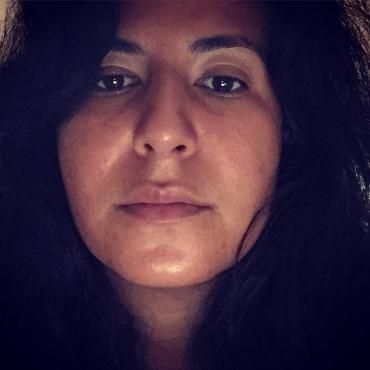

Marwa Helal is a poet and journalist. She is the author of Invasive species (Nightboat Books, 2019) and the winner of Bomb Magazine’s Biennial 2016 Poetry Contest. Helal has been awarded fellowships from Poets House, Brooklyn Poets, and Cave Canem. Born in Al Mansurah, Egypt, Helal currently lives in Brooklyn, New York. She received her MFA in creative nonfiction from The New School and her BA in journalism and international studies from Ohio Wesleyan University.
Fellowship Statement
My first full-length collection, Invasive species (Nightboat Books, 2019), is the launch pad for my next work: intimacy v. isolation, exploring the impact of migration, trauma, and technology on Erik Erikson’s Stages of Psychosocial Development.
I believe in my work's potential to disrupt old ideas and catalyze conversations that create solutions. Just as “poem to be read from right to left” created a robust discussion around colonial structures in the English language, my genre-defying narrative points directly to the inherent systemic abuse in the U.S. immigration system.
This fellowship will support me as creator and teacher. Emerging means forging a path from the margins into the center, where productive conversations around craft and genre intersect with necessary discussions around race, identity, nation-making, and immigration policy, while we continue to make room for new thought; solutions.
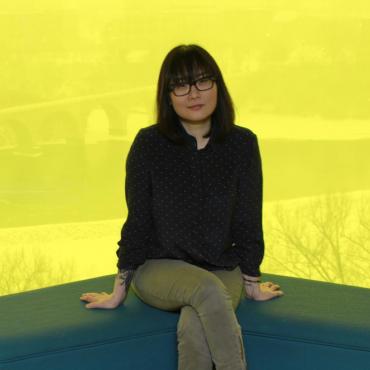

Su Hwang is a poet, activist, and the author of Bodega with Milkweed Editions, which received the 2020 Minnesota Book Award in poetry. Born in Seoul, Korea, she was raised in New York, then called the Bay Area home before transplanting to the Midwest. A recipient of the inaugural Jerome Hill Artist Fellowship in Literature, she teaches creative writing with the Minnesota Prison Writing Workshop and is the cofounder, with poet Sun Yung Shin, of Poetry Asylum. Su currently lives in Minneapolis.
Fellowship Statement
My creative practice is constantly evolving to keep pace with current events, but I also strive to acknowledge and bring to light the fraught, complex nature of our collective histories. Language is political, now more than ever––and I believe the act of writing poetry is a concrete form of resistance. My debut poetry collection BODEGA is forthcoming and I will start my second collection ROOST in earnest at Hedgebrook this summer—exploring madness, mass incarceration, and metaphors of containment. I will continue working with incarcerated writers and co-direct Poetry Asylum with poet/activist Sun Yung Shin. Our goal is to highlight and dismantle stereotypes as well as underscore concepts of invisibility in the visible, forced displacement, and transference of violence and discrimination. I aim to produce fearless work that advances my social justice goals through community building, collaboration, activism, advocacy, and open dialogue.
Photo by Jeffrey Forston Photography.


Born in Wonju, Republic of Korea and adopted to Oklahoma, Jennifer Kwon Dobbs (she/her) earned a MFA in poetry from the University of Pittsburgh and a PhD in literature and creative writing from the University of Southern California. She is the author of Paper Pavilion (White Pine Press Poetry Prize 2007), Interrogation Room (White Pine Press 2018), and the chapbooks Notes from a Missing Person (Essay Press 2015) and Necro Citizens (hochroth Bielefeld 2019, German-English editions). A recipient of grants from Intermedia Arts, Metropolitan Regional Arts Council, Minnesota State Arts Board among others, she is associate professor of creative writing and directs Race and Ethnic Studies at St. Olaf College. She lives in Saint Paul.
Fellowship Statement
Jennifer Kwon Dobbs is a transnational poet and scholar whose work confronts militarism and racial-gendered-class violence dividing kinships, selves, and imagination. Inspired by the Korean diaspora to which she belongs, she aspires to create alternative ways of feeling, knowing, and remembering to resist over sixty years of unending Korean War and its legacies. Her work has appeared previously in Agni, Blackbird, Columbia: A Journal of Art and Literature, Crazyhorse, Indiana Review, Jubilat, Korean Literature Now, Massachusetts Review, Poetry International, and elsewhere. Currently, Kwon Dobbs is developing a mixed-genre, multilingual book manuscript about white settler colonialisms and camptown kitsch in the digital age.
Photo by Thaiphy Phan-Quang.


Patricia Park (she/her) is the author of the acclaimed novel Re Jane, a modern-day reimagining of Brontë’s Jane Eyre set in Queens. She has received fellowships from Fulbright, The Center for Fiction, American Association of University Women, and others. Her nonfiction has appeared in the New York Times, Guardian, Salon, and others. She is at work on a second novel which explores the Korean community in Argentina during the Dirty War. She is Assistant Professor of Creative Writing at American University. A native of Queens, she lives in Brooklyn.
Fellowship Statement
I write about minorities within minorities. I was born here but have family from Korea and Argentina. When I was growing up, mainstream America always lumped me into the “Asian” category. But ironically enough, within the Korean community in Queens, I didn’t always feel that I belonged. In my fiction, I challenge our assumptions of the “monolithic minority.” I give voice to anyone who has felt that same loneliness; to anyone who has similarly occupied a culturally confused space.
My first novel, Re Jane, is the story of a mixed-race Korean American orphan from Queens that uses Charlotte Brontë’s Jane Eyre as a loose template to raise questions of identity and “homeland.” My second novel-in-progress, El Chino: A Novel in Four Movements, is about a boy named Juan Kim who falls in love with jazz, and the music becomes his freedom of expression during the backdrop of the Argentine Dirty War.
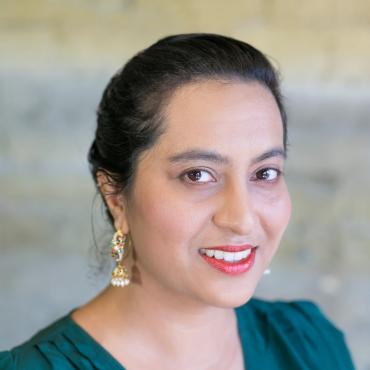

Preeti Kaur Rajpal (she/her) is a poet and nonfiction writer. She first began writing as a student of June Jordan in her “Poetry for the People” program. Preeti’s work can be found in The Sikh Review, qarrtsiluni, Memoir Journal’s I Speak From My Palms Anthology, American Public Media’s On Being Blog, Spook Mag, Jaggery Lit, Blueshift Journal, Tupelo Quarterly, Popula, Lantern Review, and others. She is a recent Loft Literary Mentor Series Poetry Fellow, Voices of Our Nations Arts Fellow, Poetry Foundation’s Poetry Incubator Fellow, and Writing By Writers Fellow.
Fellowship Statement
I am working on my first collection of poems, tentatively titled O! How We Escaped! My poems explore issues of colonialism, post-colonialism, immigrant status in the US, patriarchy, post-9/11 Islamophobia specific to the effects on Sikhs in the US, human rights issues in India, India’s Partition, my family’s journey as refugees during that time, and my understanding of Sikh philosophy.
Photo by Anna Min.


Alejandro Varela (he/him) is a writer based in New York. His work has appeared or is forthcoming in the New Republic, the Southampton Review, Pariahs (an anthology, SFA Press, 2016), Blunderbuss Magazine, the Offing, Brooklyn Rail, Joyland Magazine, the Scholar and Feminist Online, the Rumpus, and has received honorable mention from Glimmer Train Press. He was a 2017 NYSCA/NYFA Artist Fellow in Nonfiction, and a resident in the Lower Manhattan Cultural Council’s 2017–2018 Workspace program. He is also an associate editor at Apogee Journal. Alejandro holds a master's degree in Public Health from the University of Washington, Seattle. Prior to his writing career, he managed cancer-screening studies, designed HIV/AIDS health worker curriculum, and taught public health advocacy.
Fellowship Statement
I write about the complexities of class-jumping. I see strength within community, and solidarity across communities, as health intervention. I draw from public health research on stress and inequity to craft tales that paint a way forward. My hope is for readers to finish my stories and think, “Reparations for the descendants of slaves, of course!” Or “A minimum wage of $30 per hour (pegged to inflation), duh!” But I also want my writing to make people ask themselves: “How do Ben Affleck and George Clooney each have Oscars while Alfre Woodard has only been nominated once... 35 years ago?”
I’m currently finishing a collection of short stories, and I'm working on a novel about a man who returns home to care for his parents. Several of his high school friends also struggle to survive. He traces the roots of their poor health to the isolation of their formative years.
Photo by Charly Debrosse © LMCC.
Finalists in literature who agreed to be publicly acknowledged include: Sherrie Fernandez-Williams, Hafizah Geter, Naomi Jackson, Ricardo Maldonado, Harmony Neal, Christina Olivares, Jane Rose Porter, Joshunda Sanders, Purvi Shah, Cam Terwilliger, LA Warman
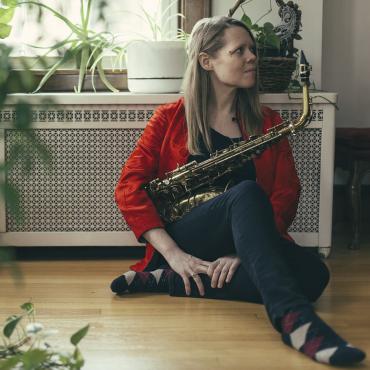

Mobile since her birth in Singapore, composer, and saxophonist Caroline Davis (she/her) lives in Brooklyn, New York. Her debut album, Live Work & Play, was featured on All About Jazz’s best releases, and she was named one of JazzTimes’ Best New Artists in 2012. Her second album, Doors: Chicago Storylines, is an audio documentary that uniquely sets stories from Chicago's jazz scene from the 80s and 90s alongside her original music. In 2018, she won the Downbeat Critic’s Poll “rising star” in the alto saxophone category. Caroline’s third album, Heart Tonic, was released on Sunnyside Records to much acclaim in NPR, the New York Times, and DownBeat. Davis’ self-titled Alula, featuring Matt Mitchell and Greg Saunier, will be released on New Amsterdam Records in May of 2019.
She has shared musical moments with a diverse group of musicians, from jazz to improvised and composed music, recently including Matt Wilson, Lee Konitz, Angelica Sanchez, Matt Mitchell, and Billy Kaye. Her regular collaborations include Maitri, Whirlpool, and Persona (with Rob Clearfield). She has participated in several mentorship programs, including the International Association for Jazz Education’s Sisters in Jazz and the Kennedy Center’s Betty Carter Jazz Ahead. In March of 2019, she will be a composer-in-residence at the MacDowell Colony to write a set of new works based on the electrical activity of neurons in the brain.
Fellowship Statement
For all my projects, I take care to design the music, hire the right performers, and work towards a message. My process involves reading articles, scribble stream-of-consciousness notes about the compositional tools, shape, and forms of each piece, and sitting down to write. For Heart Tonic, I focused on various types of arrhythmia to write the music after seeking out recordings of irregular heartbeats and speaking with patients who have this condition.
In May, I’m releasing an album of trio music (alto saxophone, synthesizers, drums) that was written in response to the vortex generator structure on most birds. I have developed a keen interest in the movements of birds, especially patterns of takeoff, flight, and landing, and the way the alula structure affects them. This work is continuing at a deeper level for the next album, which I am writing music for now.
In the immediate future, I intend to immerse myself in the study of neuron function in the brain and to improve my ability to hear/perform complex rhythms. My interest in the first topic developed when I received my PhD in Music Cognition in 2010. I want to understand how neuronal networks communicate, especially with respect to timing and motion, and develop music based on my findings. For the latter, I have been taking classes at Chhandayan Center on Indian systems of tonality and rhythm. With the help of the Jerome fellowship, I’ll be able to take private lessons and improve my abilities.
Photo by Jacob Hand.


Rafael Gonzalez (he/him), better known by his stage name Tufawon (2 for 1), is a Dakota/Puerto Rican hip hop artist/activist from Minneapolis. His name represents his mixed identity. He has traveled the world through the intersection of music and fighting for social causes. He was recently interviewed on The Breakfast Club and Hot 97 promoting Indigenous People's March in DC, and he performed at the official concert. In the fall of 2018, he completed his first headlining hip hop tour in Europe with Nataanii Means and Michel Be called “Resilience.” In January 2019, he went to Cuba through Minneapolis based nonprofit US Cuba Artist Exchange with a delegation of music producers from the states to collaborate with pioneering Cuban hip hop artists. They performed at a showcase and created two collaborative songs. Tufawon has released 4 EPs: Self Care, The Homecoming, The Send Off, and Schwag.
Fellowship Statement
With hip hop being the foundation, my music is an honest reflection of my life experiences and personal struggles/growth, my hopes and dreams for the future, spirituality and connectedness to the land, love, and the realities of the world we live in. My style is an embodiment of intricate lyricism with complex vocabulary balanced by a very clear, smooth, and concise delivery. With a socially aware approach, I touch on topics such as Indigenous resiliency, politics, health, defending Mother Earth, and fighting against oppressive systems. The underlying message in my music is always connected to freedom—the continual transformation I am experiencing is profound. You can hear it with earlier works like Schwag, where there is a bit of an egotistical and raunchy element. Compare that with later releases like The Homecoming or Self Care where themes of fighting for freedom and unlearning/denouncing patriarchy are common, you see the contrast and ultimately, the growth and transformation. I aspire to bring the vibrations of his ancestral roots into his future music projects, fusing them with contemporary production styles.
Photo by Tommy Ellis.
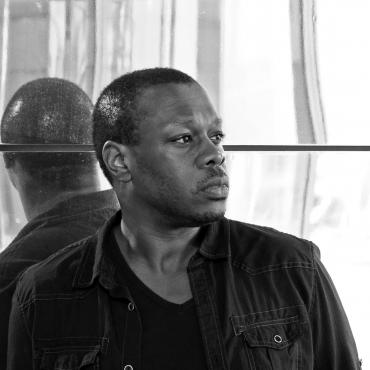

Stylistic polyglot deVon Russell Gray’s (he/him) compositions evoke soulful meditations, the envelopment of anxiety in a nurturing sonic cocoon. As a new music performer and mood scholar, he channels celestial fascination manifested in aural familiarity. deVon intuits through clairaudience a direct connection to our collective musical legacy, as guided by Bach, Beethoven, Threadgill, and Mumford.
Born and raised in the Rondo Neighborhood, the composer is a member of Saint Paul’s hip hop stalwarts HEIRUSPECS, celebrating twenty-two years of music-making and hometown-repping, as well as a decade of funding scholarships at their alma mater Saint Paul Central High School.
deVon is an omnipresence with bands, artists, scholars, and other creators. In addition, he touts music direction for new theater (Sandbox Theater’s Queens), Afrofuturistic interdisciplinary works (Joe Horton’s A Hill in Natchez), and visiting artist residencies (Cedar Cultural Center’s Midnimo Residency Program). In 2016, the Cedar Cultural Center awarded deVon funds from the Jerome Foundation to create a work for a quartet of violas and cellos plus electronics called Fractious Child, Op. 1 No. 1. In 2017, he became a McKnight Foundation fellowship recipient.
Fellowship Statement
The novelist Annie Dillard says, “How can you as a writer expect to create extraordinary work on what is likely an ordinary Tuesday?” I don’t know, yet that’s who I am. A seeker of the extraordinary. What I know, is that revelations and epiphanies come when they’re needed, no sooner.
I’ll use my skills. I will continue to create artful music that allows listeners to dream, to feel rooted, and to access the cosmos. In my art and life I aspire to achieve a level of clarity that allows me to answer simply simple questions such as, “Who are you as an artist and what do you aspire to do in your work?” Truthfully, I’m a pretty heady composer that’s always trying to dress it down. Ultimately it’s the blues. Earthy, music of the dirt. Comprised of basic elements. I will continue to keep a keen eye on my mentors where joy and mental health are concerned. This work can take its toll.
Presently and for a while now, I’ve been dreaming up an opera.
Photo by Katie Mae Dickinson.
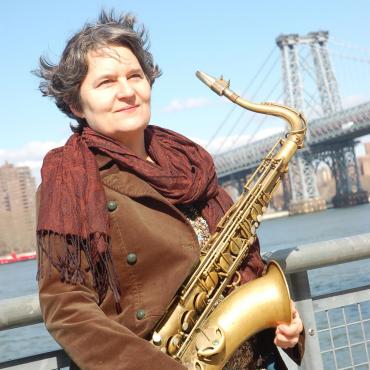

Jessica Jones (she/her) leads the pianoless group, the Jessica Jones Quartet, which features her original music and has several critically acclaimed recordings. The group has played festivals and major clubs on the East and West Coasts of the U.S. In addition, Ms. Jones is active as a sideman and has worked with Joseph Jarman, Cecil Taylor, and Don Cherry as well as a variety of Haitian, Caribbean, and African bands. She composed an opera with poet Arisa White, as well as a varied body of additional compositional work. Jones is an innovative jazz educator and consultant, working with children on improvisation, composition, and oral traditions for Jazz at Lincoln Center, Stanford Jazz Workshop, the Vision Festival, Brooklyn Friends School, and others. Currently, Jones is an Artistic Director for REVA, Inc, a non-profit created to use creative arts to inspire, educate and heal people and communities.
Fellowship Statement
I play tenor saxophone and compose. My primary body of work is for my two-tenor saxophone, pianoless jazz quartets. I write for the strengths of the band, creating frameworks for free improvisation. This celebration of diversity represents my deep belief in listening for the strengths of individuals as a key to stronger unity. Voices are a strong influence on my compositions, which often incorporate spoken or sung music, or lines that are phrased based on speech patterns. I am currently working on a “poetry opera” with poet Arisa White, as well as continuing to expand my compositions for vocalists in a jazz context, and continually developing repertoire and rapport with my Quartet. I continue to study deeply in the jazz tradition, mining the great jazz improvisers and composers to strengthen my skills as a player and composer.
Photo by Cheryl Richards.
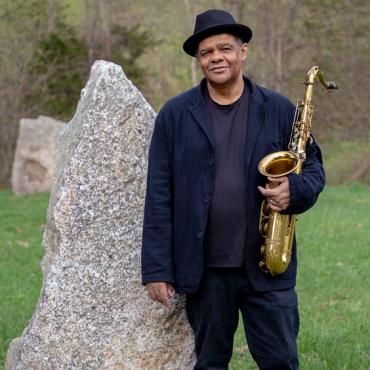

Anthony Jones (he/him) grew up in a hotbed of jazz education in Berkeley California where he was steeped in music at home and trained in some of the earliest jazz education programs in the nation, including Berkeley High School and UC Berkeley’s Young Musicians Program. While still in high school, Jones was part of an innovative cooperative quartet that performed bold experimental music around the Bay Area and on an East Coast tour where they were exposed to the still thriving loft jazz scene. Jones co-founded the Jessica Jones Quartet and the Pitch, Rhythm and Consciousness Trio and subsequent configurations with Charlie Burnham; both groups record and perform extensively. He has appeared as sideman with Don Cherry, Muhal Richard Abrams, Peter Apfelbaum, and Joseph Jarman, among others, including in national and international jazz festivals.
Fellowship Statement
There is a natural geometry and architecture to my hearing that I try to explore and reveal through my improvisation and composition. The use of contemplative silence and restrained placement by the musicians is the kind of language I am developing with my band as a unit, and what I am exploring in my compositional direction. My compositions and playing call on all aspects of the African-American music continuum, including the intersection of free improvised music with R&B and jazz. The resulting music has an exploratory, modern searching bent. The current focus of my work consists of the use of certain musical phrases, gestures, and forms from, but not limited to, this music. I seek to develop this both as a composer and a player, in different ensembles but with a particular focus on Pitch, Rhythm and Consciousness.
Photo by Marc Greene.


Composer/Pianist/Producer Migiwa Miyajima’s (she/her) career path began on a very different trajectory from composing music—she worked as a director of real estate ads, an IT engineer, and an editor-in-chief of a travel magazine in Tokyo. But in 2004, at the age of 30, she decided to become a musician. Five years later, the Vanguard Jazz Orchestra, a historic New York-based ensemble, invited her to join their team. She was the associate producer for two Grammy Award-nominated albums by the orchestra in 2011 and 2014. In 2012, having received a Japanese government scholarship as a composer and a Japan-US Friendship Commission Fellowship, Migiwa made her move to New York. Her ensemble Miggy Augmented Orchestra’s debut album Colorful was released by ArtistShare in 2018. She is one of the recipients of the 2020 New York City’s NYC Women’s Fund For Media, Music and Theatre.
Fellowship Statement
Experiencing the massive 2011 earthquake in Japan transformed my approach to my life’s work as a composer. I witnessed the inconceivable ability music has to speak to us as a people during chaotic times. Since then, I am most interested in music as a language that speaks to our emotions directly. After moving to the United States and seeing fear and lack of happiness turned into hatred and division, it feels that this is the time for me as a composer/musician to cultivate what I learned in Japan. In my upcoming project, I am practicing how to make my music work on fear or insecurity and how to cultivate positive energy through it. I am delighted to be inspired by this amazing community while I am tackling this profound theme.
Photo by Hayato Sakurai.


Alicia Hall Moran’s (she/her) critically-acclaimed albums (Heavy Blue, Here Today) embrace Opera, Soul, Jazz, Theatre, and Visual Art. Shows/explorations include “the motown project”; “Black Wall Street: Tulsa Race Riot of 1921”; and “Breaking Ice: Battle of the Carmens.” Further collaborations live inside the artworks of Carrie Mae Weems, Adam Pendleton, Joan Jonas, Bill T. Jones/Arnie Zane Dance Company, Simone Leigh/Liz Magic Laser, Carl Hancock Rux, and Ragnar Kjartansson, and are exhibited worldwide.
Residencies/commissions include Isabella Stewart Gardner Museum, National Sawdust, MoMA, ArtPublic, Brooklyn Youth Chorus, The Kitchen, and River to River. Her contemporary sensibilities were tapped for Broadway’s Tony-winning Porgy and Bess, starring as Bess on National Tour. Her artistry with husband/pianist Jason Moran has yielded Bleed/Whitney Biennial, Work Songs/Venice Biennial, Two Wings: Music of Black America In Migration/Carnegie Hall; and the Ford Foundation’s Art of Change fellowship. Ongoing, Alicia balances composition with solo vocalism in symphonic works: through 2020 in Gabriel Kahane’s emergency shelter intake form and Bryce Dessner’s Triptych.
Fellowship Statement
As a mezzo-soprano and composer, my sense of harmony, evidenced in film, recorded output and stage performances, both entices and subdues established notions of Performer and Performance. Profound historical divisions are the jump-off points for my previous musical investigations. Class difference in the review and catalogue of Black Music is another interest. My practice is non-hierarchical and plainly observes the music of the West.
In my forays, textual and sonic, Voice itself is an embodiment. My aim has been to find a new harmony inside of my work between Performance, Performer, and Practice. The Jerome Fellowship enables deeper exploration of venues previously off limits, collaborations too impractical to previously entertain, and visual realms that were technically unavailable. Traveling to Natural settings will sharpen specificity in my work. I will re-engage my recent work on ice to continue the investigation: metaphors for expressions of fragility and civility in critically trying Times.
Photo by Charles Roussel/Prototype Festival.


Walken Schweigert (he/him) is a performer, composer and director from Saint Paul, MN. He is the founder and artistic director of Open Flame Theatre, an all queer/trans ensemble that creates surrealist and queer-centered work. Walken is a 2009 graduate of the Dell’ Arte International School for Physical Theatre, and a 2006 graduate of the Perpich Center for Arts Education (Theatre Major). He has worked with the Taller Xuchialt and Ronda de Barro in Leon, Nicaragua; toured with and been mentored by the internationally renowned Double Edge Theatre in Ashfield, MA; and has busked on the streets of 11 countries. A classically trained violinist, he has been part of over a dozen musical ensembles of varying genres, from klezmer to metal. Walken was recently the recipient of a JFund award from the Jerome Foundation via the American Composers’ Forum for the composition of his second opera, The Garden, to be produced by Open Flame Theatre and Philadelphia Community Farm.
Fellowship Statement
I see my role as an artist as someone who crosses, transgresses and thrives in between boundaries. My mission is to create original, multi-disciplinary performances rooted in the queer/trans experience. Through exploring the surreal and fantastic, I seek to liberate the imagination which I recognize as a vital part of the larger struggle for justice and freedom.
What is the relationship between ritual and performance? Between song and story? How do we celebrate together? How do we grieve together? How can we harness the power of story and song to liberate our imaginations and expand our creative potential? What new traditions/rituals/rites of passage can we make for and with each other that affirm and express who we truly are? This is what I hope to explore in my fellowship. I hope at the end of it I will have made an honest contribution to a transforming cultural fabric.
Photo by Connie Chang.
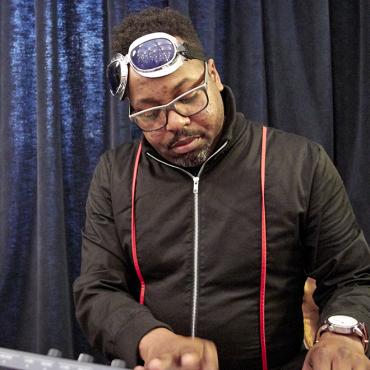

Dameun Maurice Strange (he/him) is a sound artist, multi-instrumentalist, and award-winning composer whose conceptual chamber works, choral pieces and operas are focused on stories of the African diaspora, often exploring Afrofuturist themes. In 2011, he partnered with award-winning choreographer Erinn Liebhard to present Railing Forward, a suite inspired by the legend of John Henry. The following year he was commissioned by the contemporary dance ensemble Alternative Motion Project to compose music for their premier program, Prometheus, Fire bringer and Lost in My Mind. This relationship would last 5 years and include NTimeBeautyN, HeartBeatRed, Penumbra|Corona.
In 2013, Dameun presented his first composition recital of new works, New Constellations at the Baroque Room in Saint Paul. In 2015 he presented his third composition recital which featured a cantata for Chamber Choir, Poet and Soprano, Resonant Frequencies: Love and Revolution. Strange was awarded the Minnesota Emerging Composers Award by the American Composers Forum in 2015 which led to the development his first opera, Mother King.
Fellowship Statement
I am a sound artist, multi-instrumentalist whose conceptual chamber works, choral pieces and operas are focused on stories of the African diaspora, often exploring Afrofuturist themes. I am compelled to express through sound and poetry, the beauty and resilience of the Black experience, digging into a pantheon of ancestors to tell stories of triumph, while connecting the past, present, and future. While my sound experiments have many dimensions, I use West African polyrhythms, with classical music forms, contemporary jazz harmonic explorations, along with found sounds and historic recordings to create modern Afrofuturist performances that disrupt the notion of genre and what Black music is and can be and moreover what Blackness is and can be.
Photo by Jim Nihart.


Mazz Swift (she/her) is violinist, vocalist, composer and conductor working at the intersection of composition, improvisation, and performance. She engages audiences with her signature weaving of improvisation and composition, combining elements of classical, folk, rock, jazz, free improv and electronica to create a rich, unique and diverse musical experience. As a violinist, Mazz plays electric and acoustic instruments and has performed and recorded with a wide range of artists from Butch Morris to Bruce Springsteen and Idina Menzel, and with her own band, MazzMuse. As a composer, Mazz has received commissions from the Los Angeles Philharmonic, Banff Centre for Arts & Creativity, and others. As an improviser, Mazz plays with Nicole Mitchell, The Silkroad Ensemble, and her collaborative trio HEAR in NOW. She is active as a conductor and educator, and has performed and taught workshops in free improvisation and Conduction (conducted improvisation) on six continents. Mazz lives in Brooklyn.
Fellowship Statement
I believe fiercely in the power of improvisation to improve people's lives. As a violinist, vocalist, conductor, and composer, I incorporate improvisation into everything I create and have witnessed its transformational force in performances, workshops, conversations, and collaborations. Practicing, hearing, and witnessing improvisation creates profound human experience.
I revel in the art and craft of composition—conjuring textures and moods, generating vibes and grooves, constructing a whole from many parts. My practice of mindfulness and compassion through meditation—in music and in life—compels me to use whatever power I have to foster awareness: in myself, in my music, and in the world, with an aim toward radical change. I want to uplift anyone who is willing to listen. In every area of my life, I aspire to transform and be transformed.
Photo by Nisha Sondhe Photography.
Finalists in music who agreed to be publicly acknowledged include: Mario Diaz de Leon, Eric Frye, Ritika Ganguly, Jessica Meyer, Aida Shahghasemi, Tarek Yamani
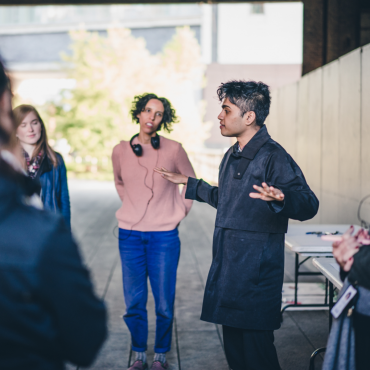

Janani Balasubramanian (they/them) is a writer, game designer, and immersive theater maker whose work has been presented on stages across North America and Europe, including The Public Theater, High Line, MoMA, Abrons Arts Center, Andy Warhol Museum, Red Bull Arts, Ace Hotel, Brooklyn Museum, and the Metropolitan Museum of Art. Residency support for this work has included the NEA, Public Theater Devised Theater Initiative, and Mount Tremper Arts. Balasubramanian is currently a 2018-2020 Van Lier fellow at the Public Theater as well as artist-in-residence with the brown dwarf astrophysics group at the American Museum of Natural History. Current projects include Rogue Objects, a live audio game about a celestial object struggling with its consciousness; Transference, a collaboration with stellar astronomer Dr. Natalie Gosnell; Harold and Okno, a Cold War era novel about an extraordinary friendship; and Night Chicken, a farm animal jazz musical.
Fellowship Statement
I am invested in continuing to explore audio-immersive games as a theatrical form. Additionally, I am interested in collaborating with artists in music, film, and VR to develop even newer forms together. I also seek to build from the methods I have developed while in residence with the brown dwarf astrophysics group to collaborate with scientists in other fields. I hope to discover what I, as an artist, can learn from each scientific field’s research practices, and contribute to the rich, historical, and ongoing exchange between theater and science. Finally, I hope to build my fluency with relaxed performance and other accessible theater-making methodologies, and create both large-scale and intimate performance experiences that expand our notion of what contemporary theater can look like, and who and where its audience can be.
Photo by Anna Hadjo.
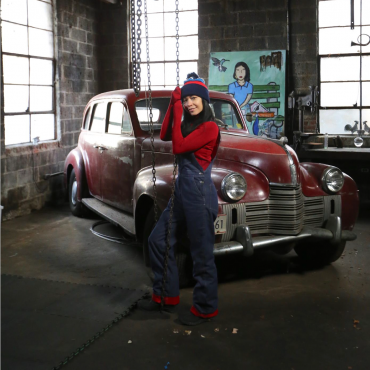

Considered one of America's leading spoken word poets, Caridad De La Luz (she/her), aka La Bruja, is a multi-faceted performer named in the “Top 20 Puerto Rican Women Everyone Should Know” (La Respuesta). Known as a “Bronx Living Legend,” Caridad has received a Citation of Merit from the Bronx Borough President as well as The Edgar Allan Poe Award from The Bronx Historical Society. She has performed at The Apollo, Lincoln Center, Gracie Mansion, Cathedral of St. John the Divine, City Hall in New York City and many international venues. Since her 1996 debut performance in the famed Nuyorican Poets Café, she continues to host Monday Night Open Mics where people from all over the world come to perform. The New York Times called her “a Juggernaut" and she is currently cultivating her own art space in the Soundview area of The Bronx called “El Garaje” where she lives.
Fellowship Statement
As an artist connected to ancestral knowledge through my Puerto Rican, Bronx and Taino roots, I create work that speaks about our realities and injustices, as well as to Feminist, Latinx, LGBTQ and POC communities. My goal with this grant is to expand my knowledge of Indigenous practices by visiting artists and healers of First Nations along the Northwest Coast of North America, Peru and Africa. With this knowledge, I will expand my creativity and offer healing circles in The Bronx where I’ve lived my entire life. Through meeting new contacts, I will also be able to invite healers and artists to create and share their knowledge in my space, El Garaje, through creative residencies in the future. My artistic work has always included healing, which is why I chose the stage name “La Bruja” (aka The Witch). My intention is to create transformation via art and Indigenous worldview healing practices.
Photo by Ted Lopez.
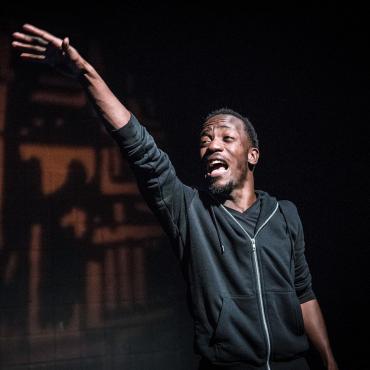

Antonio Duke (he/him) is a Twin Cities-based actor, playwright, and teaching artist. He worked with Pillsbury House Theatre as part of the Summer 612 Micro Grant (2011 & 2012), Late Nite Series (2012) and Naked Stages Fellowship (2018) where he created his solo performance play Ashes of Moons. His solo performance play Tears of Moons was part of the Guthrie Theatre’s Solo Emerging Artist Celebration. Antonio’s plays The Death of Kings and The Fog premiered as staged readings at the Guthrie Theatre for The New Griots Festival. His play The Sly Sambo appeared as part of the Fresh Ink Series at the Illusion Theatre. The Fog garnered him The Many Voices Mentorship from The Playwright Center. He's the recipient of the 2019 Artist Initiative Grant through the Minnesota State Arts Board for his solo performance play Missing Mississippi Moons. Training: University of Minnesota/Guthrie BFA Actor Training Program.
Fellowship Statement
My artistic aim is to create stories from the black diaspora as authentically as possible. In my writing I focus on mythology. Within mythos lies intimate and epic circumstances that I am driven to explore. I conjure most of my muse from black spiritualities; specifically, those deities from the Afrocentric Yoruba, Santeria and Voodoo traditions. In my work, I speak about trauma, both personal and historical. Performing traumatic events with Afrocentric cultural aesthetics is important to me because it provides me with the chance to connect with my ancestors. In doing so, I follow in a lineage of West African storytellers called Griots. Stories are strange spells. They are conjurations in our mouths. Playwriting and performance is a spiritual manifestation act rooted in an ancient practice of Afrocentric storytelling. It is through this practice that I can sit with the ancestors that I have yet to meet.
Photo by Bruce Silcox.
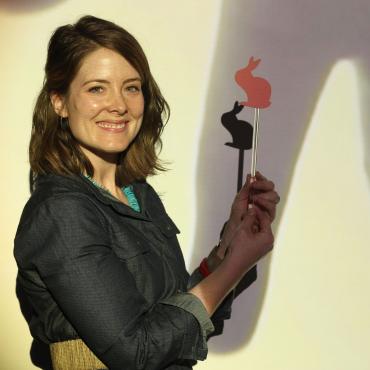

Megan Flød Johnson (she/her) is a socially engaged “theatre for youth” artist who brings together youth and their communities through play to spark social action. She co-creates with communities around the country exhibits, events, residencies and performances for the very young.
THE NEST (2014) is an evolving installation about an illusive creature inhabiting public spaces revealed through child-led curation and storytelling. Children’s ideas transform space into a layered, narrative playscape capturing identity(ies) of place, youth assets and reflections on welcoming a stranger. THE NEST was developed at Children's Museum of Pittsburgh (remounted in 2017) and has since traveled to Santa Cruz Museum of Art & History, Noah's Ark at Skirball Cultural Center in Los Angeles, and summer 2019 as an exhibit with the St. Louis Public Library system. THE NEST is the subject of a documentary by filmmaker Alicia Rice called When Kids Meet a Creature.
Megan resides in Saint Paul, MN where she is a Teaching Artist and Program Developer for SteppingStone Theatre and Art Center of Eden Prairie. She holds an MFA in Theatre for Youth and graduate certificate in Socially Engaged Practice from Arizona State University and BA’s in Theatre and Music from Lawrence University in Appleton, WI.
Fellowship Statement
I am a socially engaged “theatre for youth artist” who brings together youth and their communities through play to spark social action. I seek to disrupt dominant narratives and expectations for young people to designate new spaces for process, dialogue, experimental thinking, play and welcoming multiple points of view. Youth agency is central in my work, which experiments with models of participation through performance, unstructured play and hands-on making.
I am working on developing a mobile version of my installation playscape, THE NEST about an elusive creature whom children build a temporary home for in public spaces. I will experiment with different models of engagement for the project including city-hosted events, guerrilla pop-ups, and an original performance. I hope to bring pop-up NEST experiences to youth and families in places where they already are—in parks, parking lots, apartment buildings, clinics, schools, and/or shopping malls.
Photo by Alicia Rice.
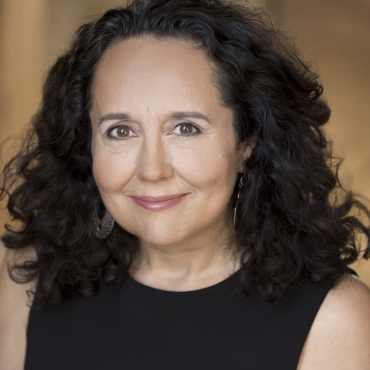

Kathryn Haddad (she/her) is a writer, teacher and community organizer whose work explores contemporary Arab American experiences and reflects on the political reality of life for Arab Americans. Kathryn founded Mizna – one of the few Arab American Arts and literary organizations in the United States and served as Artistic/Executive Director for twelve years. She’s a recipient of a Bush Fellowship for work with the Arab American community and received three Playwright’s Center Many Voices Fellowships. Her plays have appeared in various venues, including the anthology, Contemporary Plays by Women of Color. Kathryn was awarded the 2018 Kay Sexton Award at the Minnesota Book Awards for her literary impact on the State of Minnesota through her work with the Arab American community.
Fellowship Statement
I strive to tell Arab and Arab American stories through theater - reflecting on the social and political climate at home and abroad. Immigration, family life, political struggle, colonization, religion, and bicultural experience have all been subjects I have explored. This award will give me the opportunity to work with community to continue the dialogue and conversation through art. The fellowship will allow me time to work on my craft as a playwright and strengthen my writing through study and practice. I would like to make new connections and collaborations with theaters, individuals, and communities that share a common vision, and I hope to reach new audiences with my work.
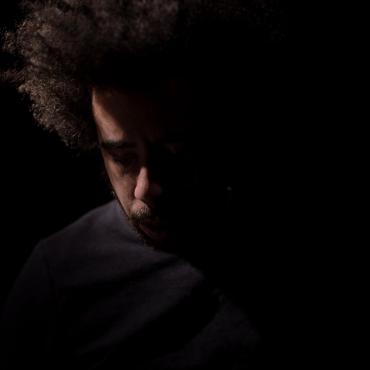

Joe Horton (he/him) is a rapper, artist, and founding member of FIX music and arts collective. His interdisciplinary work spans medium and genre, but always features a signature blend of futurism and mysticism. The best example of this is his latest work, A Hill in Natchez, is a surreal work that combines elements of dance, visuals, and music. Joe is currently working on a new album produced by Anatomy (Kill the Vultures) as well as VESSEL, a visual and musical work that will premiere at the Minneapolis Institute of Art in Fall 2019.
Fellowship Statement
I owe as much to the mystical tradition as I do the artistic. I am interested in nurturing vital knowings that come directly from the Mystery. I want to marry ancient techniques of ecstasy and forward-thinking technologies. I want to sing to the moment as it passes.
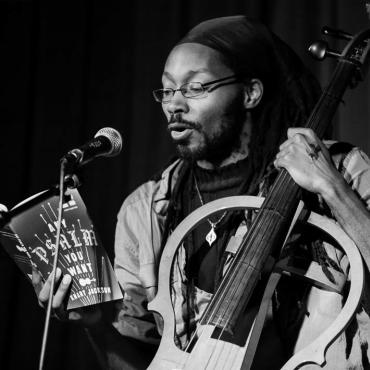

Khary Jackson (he/him) is a poet, playwright, dancer and musician. He has written several plays, one of which (Water) was produced in 2009 at Ink and Pulp Theatre in Chicago. As a hip hop/street dancer he was fortunate to create and perform a piece at the 2018 Choreographers’ Evening at Walker Art Center. He has been a recipient of several generous grants, including the 2016 McKnight Artist Fellowship in Writing, the Minnesota State Arts Board’s 2012 Cultural Community Partnership Grant and 2010 Artist Initiative Grant for Poetry, the Many Voices Fellowship from The Playwrights’ Center in 2005 and 2007, as well as the 2009 VERVE Spoken Word Grant from Intermedia Arts. He is an alumnus of Cave Canem, the esteemed writing fellowship for black writers. His first poetry book, Any Psalm You Want, was published with Write Bloody Publishing in the spring of 2013.
Fellowship Statement
It is my aim to use multiple artistic mediums in the service of a greater, unifying idea. After years of focus on individual areas of arts composition and performance, this feels like the time to bring them together, and create artistic experiences that can speak to someone on multiple levels of engagement. I am looking at poetry/creative writing as the grounding element in a collaboration with dance, music, video and visual art. I want others to hear more of what I’m hearing, see more of what I’m seeing, and, perhaps, move with me in whatever ways they can.
Photo by Erin X. Smithers.


Kareem M. Lucas (he/him) is a Brooklyn born and Harlem-based actor/writer/producer/director. His solo pieces include The Maturation of an Inconvenient Negro, From Brooklyn With Love, RATED BLACK: An American Requiem, A Boy & His Bow, and Black Is Beautiful, But It Ain’t Always Pretty. He is currently co-collaborating on the development of the immersive theatrical piece The Black History Museum...According to the United States of America, as a writer/performer with the Smoke & Mirrors Collaborative at HERE Arts Center. He recently presented his solo piece, RATED BLACK: An American Requiem, as a part of New York Theatre Workshop’s Next Door Series, and The Maturation of an Inconvenient Negro as part of his 2019 Mentor Project at Cherry Lane Theatre. Kareem received an MFA from New York University’s Graduate Acting Program.
For more info follow him on Instagram @KareemMLucas.
Fellowship Statement
I feel a great responsibility to articulate what it is to be Black now. Currently, my curiosity is drawn to investigating and deconstructing the Black heterosexual cis-gendered male perspective as it functions within America’s White supremacist capitalist patriarchy. How the legacy of slavery, racism, misogyny, religion and the value of the Black body over the Black mind still insinuates itself into our modern day existences and systems, as we navigate love, intimacy, identity, and self-worth in this digital media age The greatest service I may provide through my work is to communicate on behalf of my culture, so that we may reflect, heal, inspire, take responsibility, and move forward, because this lack of self-awareness, self-care, self-love, and overall accountability has diminished our progress as a people in this land for many generations.
Photo by Stan Demidoff Photography.


Ikechukwu Ufomadu (he/him) is a comic entertainer, named one of five “Comics to Watch in 2018” by Time Out New York. His original projects include: Ike at Night (The Public Theater), Nightcap | by Ike (Joe’s Pub at The Public), Ike Night (Ars Nova, San Francisco Sketchfest), Ike for the Holidays (Joe’s Pub at The Public), Ike by Chance (Ars Nova), Inspector Ike (Comedy Central Corporate Retreat), Ike’s Wonderful World of Leisure (Exponential Festival) and more. His short-form series Words with Ike has aired on VICE and IFC.
He trained at New York University’s Tisch School of the Arts; the International Theatre Workshop in The Netherlands; and Studio Five’s theatre and dance programs in Indonesia. Ikechukwu has been an artist-in-residence at Joe’s Pub at The Public and SPACE on Ryder Farm.
Fellowship Statement
As a comic entertainer, my primary objective is to entertain, comically.
My work often takes the formats of classic American variety and talk shows and sets them in performance contexts that make them feel both familiar and strange. This results in humor that is disorienting and plays with people’s expectations, while maintaining a warm, welcoming “big tent” sensibility that invites an audience of diverse life experiences to come along for the ride.
Crafting intimate entertainments that can serve as sites of shared laughter, improvisation and play is a pressing need in a time marked by deep divisions, fragmentation and social deadlock. Indeed, our deepest impasses, individually and collectively, are marked by the absence of such play. My hope is to build a body of work that succeeds as entertainment while stimulating those human qualities necessary to not only cope with the problems of our time, but resolve them.
Photo by Mindy Tucker.
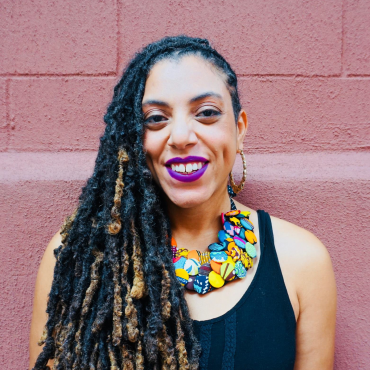

Nia O. Witherspoon (she/her) is a black queer writer/director, vocalist/composer, and cultural worker. Described as “especially fascinating” by Backstage Magazine, and named in Phoenix’s “Top 100” Artists, Witherspoon’s work creates contemporary ritual-space grounded in African Diaspora sensibilities to speak to the issues of our times. Currently in residence at Brooklyn Arts Exchange, Witherspoon has received New York Theatre Workshop’s (NYTW) 2050 Playwriting/Directing Fellowship, BRIC’s Premiere Residency, Astraea Foundation’s Global Arts Fund Grant, Brooklyn Arts Fund (BAC), Downtown Urban Theatre Festival’s “Audience Award,” Lambda Literary’s Emerging Playwriting Fellowship, and a Mellon Dissertation Fellowship. Her works, including The Messiah Complex, YOUMINE, and SHE have been developed or featured at BRIC, HERE, NYTW, National Black Theatre, BAAD, Dixon Place, The Fire This Time Festival, and Movement Research. Witherspoon holds a PhD from Stanford University, and is currently a Playwright-in-Residence at University of Massachusetts (Amherst). She has works commissioned in the 2019-20 season by The Shed, Playwright’s Realm, La Mama ETC, and JACK.
Fellowship Statement
I am a concept-driven artist invested in creating spaces where black/queer/trans/female folks, and, more largely people of color, are able to be seen in their full humanity, and their full divinity. This means that while contemporary tragedy and inter-generational trauma often trigger a project’s inception, ultimately, I aim for my works to place my communities in a context that far exceeds the 500-years of colonial time and instead to find the palimpsest of wisdom in liberation. Freedom is not something I have achieved yet, but it is something I feel pulled uncontrollably toward. I am working to cultivate freedom in myself, in my works, and in my collaborators, by any means necessary. I am also learning that freedom is very much about surrender to the imperfect, and so I try to create spaces (from plays to rituals to rehearsal rooms) where vulnerability is the most valuable currency.
I am deeply inspired by the resonance inside of dissonance—particularly in reparation of the sacred/secular binary. I am also invested in the concepts of layering and unfolding, as the nature of diaspora is palimpsestic, cyclical, and always in motion. In The Dark Girl Chronicles, Yoruba divination scripture lives alongside verbatim investigation-room testimony, court transcripts, and Cardi B to unearth the stories of black women warriors against state violence. I am excited by the potential of theatre to allow us to see what we would otherwise not see—the moonlit vision—the “magic eye” that offers a window the Great Mystery. In The Messiah Complex, the nightclub has permission to become the ritual ground and sacred cemetery. A heteronormative Black Panther has permission to love a transwoman. And his transmasculine child has permission to become the Messiah, leading the next generation of the black liberation struggle.
Photo by Zavé Martohardjono.
Finalists in theater, performance & spoken word who agreed to be publicly acknowledged include: Raquel Almazan, Marisa Carr, Darian Dauchan, MJ Kaufman, Gian Marco Riccardo Lo Forte, Federico Restrepo, Elizabeth Senja Spackman, Caitlin Saylor Stephens, Z Puppets Rosenschnoz: Shari Aronson & Chris Griffith
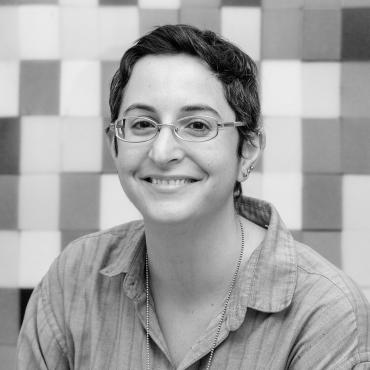

Manal Abu-Shaheen (she/her) is a Lebanese-American photographer, born in Beirut, and currently living and working in Queens, New York. Her recent solo exhibitions include Theater of Dreams, Bernstein Gallery, Princeton University, NJ; Beta World City, LORD LUDD, Philadelphia, and Familiar Stranger, A.I.R. Gallery, Brooklyn. Her work has been included in group exhibitions at Amelie A. Wallace Gallery, Old Westbury, New York; The Society of Korean Photography, Seoul, Korea; Queens Museum; The Center for Fine Art Photography, Fort Collins, CO; and The Bronx Museum of the Arts. She is a recipient of the Aaron Siskind Foundation Individual Photographer’s Fellowship Grant, Jerome Foundation Travel and Study Grant, Lower Manhattan Cultural Council Workspace Residency, A.I.R Gallery Fellowship, and Artist in the Marketplace Residency at the Bronx Museum. Abu-Shaheen holds a B.A from Sarah Lawrence College and MFA in Photography from Yale School of Art. She teaches at The City College of New York.
Fellowship Statement
My work focuses on the ways in which globalized communication brings idealized images from one culture in contact with the realities of another. Motivated by a lack of visual history of the landscape in Lebanon, I am building my own photographic archive of what Beirut looks like today: a city dominated by billboards. In one sense the advertisements serve as a visualized end energizing capitalist growth, and in another they purport a mythologized western ideal that is incongruous in the post-conflict city. The advertisements and pervasive neo-liberal capital represent our most recent form of colonialism. What is fascinating to me about this system is that it employs images as its most powerful tool. This under-documented place is now occupied by images of a different place and people.
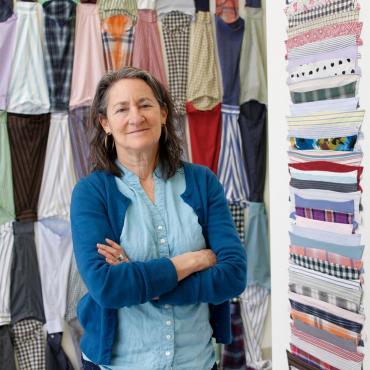

Rachel Breen (she/her) has exhibited her work across the Twin Cities and nationally. She has received several Minnesota State Arts Board grants, a fellowship from the Walker Art Center Open Field and an artist residency at the Virginia Center for Creative Arts. Rachel’s social engagement projects have twice been a part of Northern Spark, an all-night public art festival addressing climate change. Rachel is a professor of fine art at Anoka Ramsey Community College in Coon Rapids, Minnesota.
Rachel holds an MFA from the University of Minnesota and received her undergraduate degree from The Evergreen State College. She worked as a community organizer for social justice organizations and political campaigns across the country and is a co-founder of Jewish Community Action in Minnesota. These experiences influence the process and content of her art today. Rachel was born and raised in Minnesota. Her ancestors had roots in Poland, Lithuania and Belarus.
Fellowship Statement
At the core of my practice is a sewing machine, which I use to draw, create installations and perform. I describe my work as “public making” as it encourages reflection about social concerns. Through acts of sewing, I divert sewing’s original purpose, that of creating, toward social critique. I call attention to the stitch as a symbol of human interdependence, and I use it to express a belief in the possibility of social change and repair.
My recent work examines the implications of two garment workplace tragedies, the 1911 Triangle Shirtwaist Factory fire in New York City and the 2013 Rana Plaza Factory collapse in Bangladesh. I connect these tragedies to raise questions about the relationship between overconsumption and the abject working conditions of garment workers. With this fellowship, I plan to continue investigating these questions, focusing especially on matters of scale, materials, and public participation.
Photo by Justin Allen.


Jes Fan (they/them) is a Brooklyn-based artist born in Canada and raised in Hong Kong, China. They are the recipient of various fellowships and residencies, such as the Joan Mitchell Painters and Sculptors Grant Recipient, Recess Art Session Residency, Bemis Center Residency, Van Lier Fellowship at Museum of Arts and Design, Pioneer Works Residency, John A. Chironna Memorial Award at RISD. Fan has exhibited in the United States and internationally; selected exhibitions include Mother is a Woman at Empty Gallery (Hong Kong), Disposed to Add at Vox Populi Gallery (Philadelphia), Whereabouts at Glazenhuis Museum (Belgium), Material Location at Agnes Varis Gallery (New York), Ot(her) at Brown University’s Sarah Doyle Gallery (Providence). They received a BFA in Glass from Rhode Island School of Design.
Fellowship Statement
My studio practice is rooted in a haptic approach to understanding how identity is materialized, biologically and ontologically. I use substances such as hormones, silicone and soap—materials that are imbued with erotic and political signifiers to articulate my concerns about diasporic politics, transgender identities, and posthumanism.
Currently, I am working on new film, titled Xenophoria. Xenophoria, at first glance, simulates a YouTube cooking video, but the narrative quickly dives into the lab process of melanin production. Here, E. coli bacteria is used as a host, allegorical to ways in which miscegenation has been viewed as a dangerous contamination, and broader anxieties of racial intimacy. The mood of the video shifts and the camera turns to medical portraitures of the 19th century by Lam Qua. A set of paintings that depicts tumors of patients in the Canton region. These paintings ascribe to a colonial period when race and character is still not fully taxonomized, and medical science was sought out as a tool to dissect race as a distinct category. The film ends with a sudden jolt to an interview with a researcher who proposed to harness melanin's anti-radioactive properties for interspace travel in the near future.
My work magnifies the surreal realities of existing as a biological body in the age where the body is reconceptualized in digital, informational and molecular terms. It dwells in this productive anxiety and offers no resolution to identity politics that are riven by binaries.
Photo by Han Minu.


LaMont Hamilton (he/him) is an autodidact interdisciplinary artist living and working in New York. Hamilton uses lens, performance, writing and sound amongst a variety of other mediums to negotiate between the material and the conceptual. His practice as an artist is considered visual art, but he strives for synesthetic engagements that decentralizes the ableist assumption of the “visual” and considers how bodies engage with work.
Hamilton has been the recipient of several residencies, fellowships and awards including the Jerome@Camargo residency in Cassis, France, Skowhegan School of Painting and Sculpture, MacDowell Colony, MFAH CORE program in Menerbes France, Smithsonian Artist Research Fellowship, Artadia Award, ArtMatters Grant, Artist in Residence at Duke University’s African and African American Studies, Bemis Center for Contemporary Art amongst others. Hamilton has also showed at institutions such as MoMA, The Kitchen, ISSUE PROJECT ROOM, Studio Museum in Harlem, Schomburg Center, The Drawing Center and The Sculpture Center.
Fellowship Statement
I see myself in the tradition of those who view the role of “the artist” as a specific calling. One doesn’t simply choose to be an artist but is moved, deeply, into this space of wonder. We are all born with (various forms of) antennas which we use to perceive the world, but the artist is ignited to make sense of this perception. This (re)imagination is at the crux of the current direction of my practice. Whereas before my commitment was to the historical, in a pivot, I am now fully invested in art’s capacity for deep meditation, transformation. I am engaged in two working principles—Transrealistic poetics and Barulhos—first presented by poets Norman H Pritchard and Ferrier Gullar (respectively), to provide an open-ended structure for this investigation.
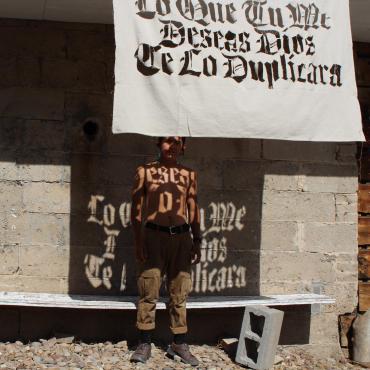

Jonathan Herrera Soto is a print-based studio artist originally from Chicago, IL, and currently maintains a studio practice in Minneapolis, MN. He graduated with a BFA from the Minneapolis College in Art and Design in 2017. Recent solo exhibitions of Jonathan’s work include Querida Presencia at the Duluth Art Institute in Duluth, MN, and Entre Rios y Montañas at Annex Gallery in Chicago, IL. He has participated in numerous artist residencies including Yaddo, Saratoga Springs, New York; The Studios at MASS MoCA, North Adams, MA; 33 Officia Creativia, Toffia, Italy; Spudnik Press Cooperative, Chicago, IL; High Point Center for Printmaking, Minneapolis, MN; Vermont Studio Center, Johnson, VT; and Epicenter, Green River, Utah. Herrera Soto was a 2018 recipient of the Santo Foundation Individual Artist Award and the Minnesota State Arts Board Artist Initiative Grant.
Fellowship Statement
I construct print-based objects, installations, and environments that echo lived experiences of those who are no longer with us. My print-based processes of producing tracings and impressions translate the content through the symbolically revealing the act of remembering. Slicing open wounds into wood, burning the surface of limestone with acid, and the crushing of ink on paper under immense pressure, re-animates acts of violence that carries through an art-object’s final presentation. I research, explore, and unpack ideas within a framework of praxis--the simultaneous conceptual framing and physical compressing of ideas through work in order to examine the spaces left behind by others. I am currently working on a series about love’s influence on ethnic bodies in constant movement—the love that guides mothers that flee their homes with their children in search for asylum, the rebels that fight against oppressive regimes, and friends that search for their missing comrades.


Hasabie Kidanu (she/her) received her MFA at the Yale School of Art in 2017. Her film Mal-Fekata was most recently screened at the 48th Rotterdam International Film Festival as part of the Bright Future program. She has been a member of the Blackburn Printmaking Studio in New York since 2013. She was most recently a guest lecturer at Addis Ababa University. Since 2014, she is an Arts and Culture writer for TADIAS Magazine.
Fellowship Statement
I work with printmaking, film, and text. I was raised in Addis Ababa, Ethiopia and often reference the city as a site of my research. I engage specific works of literature to ground and challenge my understanding of history and modernity. Currently, I am producing a film alongside a reading of Ivan Vladislavic’s The Folly. Through the back and forth of reading and production, interpretation and application, I hope to produce a site/work that is of, and apart from, my understandings of early cinema and African literature.
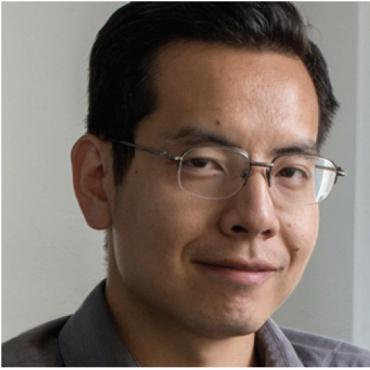

Sieng Lee is a first-generation Hmong American refugee. Lee graduated from the Minneapolis College of Art and Design with a Master’s in Fine Arts. He is an artist, graphic designer, and community organizer. His recent achievements include being a recipient of the MAEP at the Minneapolis Institute of Arts; a Cultural Community Partnership Grant from the Minnesota States Arts Board; designing and developing the We Are Hmong/Peb Yog Hmoob Minnesota exhibit at the Minnesota History Center, which won an AASLH award; and directing multiple political campaigns to elect Fue Lee, Samantha Vang, and Jay Xiong to the Minnesota House of Representatives to form the first ever Minnesota Asian Pacific Caucus. His passion lies at the intersections of our multicultural society, helping to bridge the many inequities and misunderstandings.
Fellowship Statement
My work treads a delicate line that weaves in and out of the two realms that have shaped the Hmong identity since before time: the living and the spiritual. In so doing, I introduce general audiences to the celestial mythology that shapes modern Hmong Americanism, while activating the Hmong community’s exclusive access to view, recognize, and react to their own stories on display. By using physical objects that have a spiritual, and at times controversial, significance, my work questions the performance of tradition as it has been adopted and reinterpreted from generation to generation.


Born in Puerto Rico and raised in the Bronx, Glendalys Medina is an interdisciplinary artist who received her MFA from Hunter College. Medina’s work has been presented at such notable venues as PAMM, Artists Space, The Bronx Museum of Art, El Museo del Barrio, The Museum of Contemporary Art in Vigo, Spain, and The Studio Museum in Harlem. Medina is a recipient of a Bemis Center Residency (2019), an Ace Hotel New York City Artist Residency (2017), a SIP fellowship at EFA Robert Blackburn Printmaking Workshop (2016), a BACK IN FIVE MINUTES artist residency at El Museo Del Barrio (2015), a residency at Yaddo (2014, 2018), the Rome Prize in Visual Arts (2013), a New York Foundation for the Arts Fellowship in Interdisciplinary Art (2012), and the Bronx Museum Artist in the Marketplace residency (2010).
Fellowship Statement
At age 7, I decided I wanted to be an artist–not really knowing that it was much more than making beautiful things. Today, I am an artist to give a voice to those who have been silenced and create cultural equity.
I am interested in patterns, how they are formed and give meaning. Humans are amazing pattern-recognition machines with the ability to detect their disruptions or “recursive probabilistic fractals” according to inventor and futurist, Ray Kurzweil. I investigate existing patterns in order to understand how to form new patterns of behavior, thought, structure and meaning. Patterns dictate our understanding of life and who we are, and to change these meanings, we must disrupt them and make new concrete goal-oriented patterns in order to create social change.
The style of my work is heavily influenced by systematic structures, the cadence of Hip-Hop rappers, the affirmations and visualization exercises of New Thought ministers and authors, the signatures of graffiti writers, the moves of break-dancers, and traditional Taíno motifs.
The questions I grapple with in my work are how can I create new resonant forms, architecture, actions, and movement to invoke in my viewer emotions of love and curiosity for a broader perspective of the world.
Photo by Carlos David.
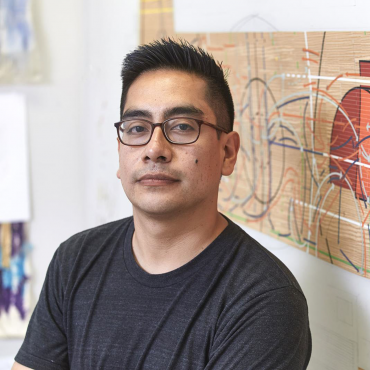

Ronny Quevedo (he/him) was born in Guayaquil, Ecuador and now lives in the Bronx. He works in a variety of mediums including sculpture and drawing. Quevedo has had several solo exhibitions including no hay medio tiempo / there is no halftime, Queens Museum (2017); Home Field Advantage, Casita Maria Center for Arts & Education, Bronx, New York (2015); and Ulama, Ule, Olé, Carol Jazzar Gallery, Miami (2013). In 2018, Quevedo was included in the Whitney Museum of American Art’s group exhibition, Pacha, Llaqta, Wasichay: Indigenous Space, Modern Architecture, New Art. Quevedo received his MFA from the Yale School of Art in 2013 and BFA from The Cooper Union in 2003. He is currently artist in residence at Smack Mellon.
Fellowship Statement
The effect of relocation and displacement generates works about adaptation, memory and transformation. The movement and action within sports is a metaphor for an insistence on survival and constant adaptation. This use of play is a subversive transformation to the rules and capabilities placed upon people when the conditions of a society become oppressive. By incorporating these games, I invoke an architectural and narrative space—where boundaries are malleable, limits are negotiable and competition is a generative force for evolving identities.
The parallels between play and migration generate from indoor soccer leagues in New York City. Played on weekends at local public schools, these leagues are coordinated and operated by migrant Latin American and Caribbean communities. The questioning of inheritance and memory are conceptual markers in my practice. The act of passing—passing down, passing on, passing the ball—offers generative contemplations of my points of origin.
My focus for the fellowship is the dialectic of nomadism and cultural production as complemented by Edouard Glissant’s Poetics of Relation. He emphasizes the influence of the periphery onto central forms of culture. He claims that the margins offer a new understanding of the center. It can be more creative in determining meaning than a static position based on an essential form. I relate to this concept of being having been born in Ecuador, raised in The Bronx (a pre-dominantly Caribbean and Black community at that time) and determining my own identity as a migrant in relation to those who have similar experiences of displacement.
Photo by Argenis Apolinario.


Dyani White Hawk (Sičáŋǧu Lakota) (she/her) is a visual artist and independent curator based in Minneapolis. White Hawk earned an MFA from the University of Wisconsin-Madison (2011) and BFA from the Institute of American Indian Arts in Santa Fe, New Mexico (2008). Recent support of White Hawk’s work includes 2019 United States Artists Fellowship in Visual Art, 2019 Eiteljorg Fellowship for Contemporary Art, 2019 Forecast for Public Art Mid-Career Development Grant, 2018 Nancy Graves Grant for Visual Artists, and a 2017 Native Arts and Cultures Foundation Fellowship. Her work is represented by Bockley Gallery in Minneapolis.
Fellowship Statement
As a woman of Sičangu Lakota and European American ancestry, I was raised within Native and urban American communities. My work reflects these cross-cultural experiences through the combination of modern abstract painting and abstract Lakota art forms. Some works are executed strictly in paint while others incorporate beads and porcupine quillwork onto a painted surface, weaving aesthetics and conceptual influences from each respective history.
I strive to create honest, inclusive compositions that acknowledge all parts of my history, Native and non-Native, urban, academic and cultural education systems. This platform allows me to start from center, deepening my own understanding of the intricacies of self and culture, correlations between personal and national history, and indigenous and mainstream art histories.
The work encourages conversations that challenge the lack of representation of Native arts, people and voices in our national consciousness while highlighting the truth and necessity of equality and intersectionality.
Finalists in visual arts who agreed to be publicly acknowledged include: Inbal Abergil, Joseph Buckley, Esteban Cabeza de Baca, Onyedika Chuke, Maya Ciarrocchi, Moko Fukuyama, Kris Grey, TJ Proechel, Lina Puerta
